Palmerston Island, Where Everyone is Related
Palmerston Island is a coral atoll in the Cook Islands in one of the most isolated part of the Pacific Ocean, about 3,200 km from New Zealand. The tiny Pacific island has no airport, and is visited by a supply ship only twice a year. The journey to the island is so long and hazardous that only the most intrepid visitors ever dares to visit it. But Palmerston’s fame comes not only from the fact it is a perfect island paradise, but from its unique history.
Palmerston Atoll is made up of a number of sandy islets on a continuous ring of coral reef enclosing a lagoon. Six of them are of significant size including Palmerston, North Island, Lee To Us, Leicester, Primrose, Toms, and Cooks, that together cover just 1 square mile (2.6 km2) in area. The atoll is 11 km across and 15 km from north to south that encloses an area of 56 square kilometers of sea.
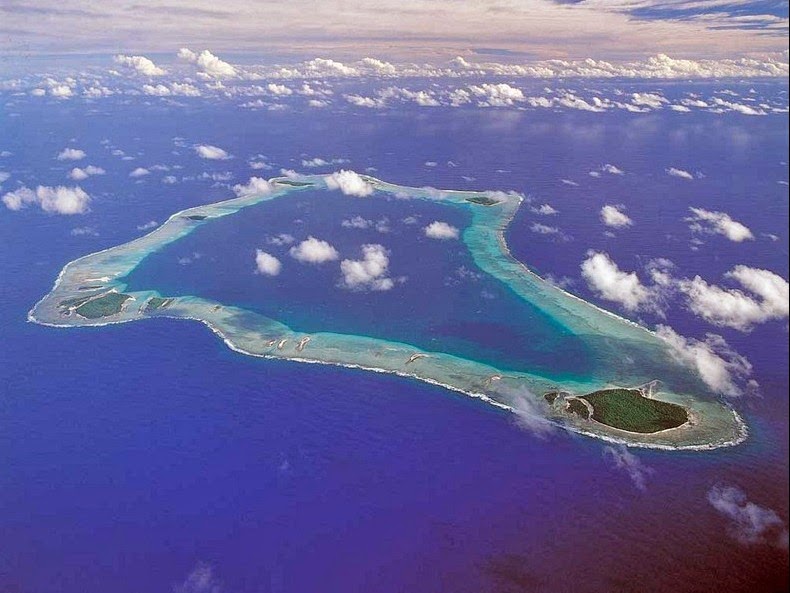
The first person to set foot on Palmerston was Captain Cook in 1777, although he had discovered the island three years earlier on another trip. Cook named the island after Henry Temple, 2nd Viscount Palmerston, then Lord of the Admiralty. The island remained largely uninhabited for almost another century when it was chanced upon by William Marsters, a carpenter and barrel maker of a whaling ship that frequented the Bay of Islands, in 1860. William Marsters was so charmed by the island that three years later he returned with a wife, the daughter of the chief of another Cook island, and her two cousins with the intention of permanently settlement on the island.
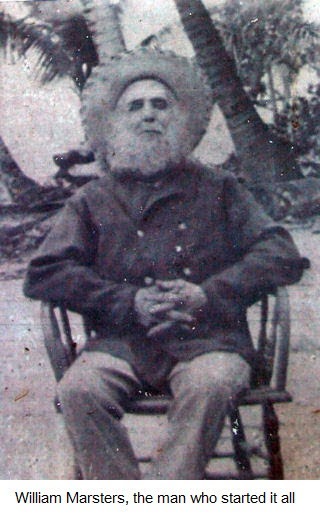
Before he died William Marsters, organized the island so that each of the three wives and their descendants had a share of the main island and each of the atolls. This arrangement still stands. Today the Island has its own Council, representing the local government, and members of the three family. Marriage within a family group is prohibited.
Palmerston Islanders still pride themselves on their British heritage – they fly the British flag on special occasions, have large photos of the Queen in their homes, and remember fondly the visits of the Royal Yacht Britannia. Although it is administered by the Cook Islands government under the jurisdiction of New Zealand, in 1954 the family was granted full ownership of the island.
Life on Palmerston is simple. There are no shop, just two toilets, and rainwater is collected for drinking water. Money is only used to buy supplies from the outside world not from each other. Electricity runs from 6am – 12pm each day and again at night. A recently built telephone station provides the only permanent link to the outside world. Fish is the islanders' staple food and their only export. One or two tons of parrot fish are frozen and collected by the supply ship which comes twice a year to deliver essential supplies such as rice and fuel.
Aside from the cargo ships, the island sees about a dozen visiting boats a year bringing tourists. Since there are no resorts or hotels, by custom, the family that first greets the visitors offer them a homestay at their house.
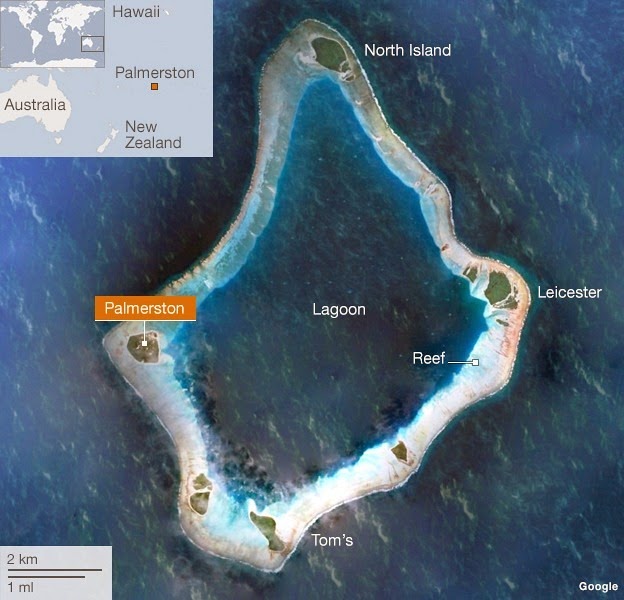
Photo credit
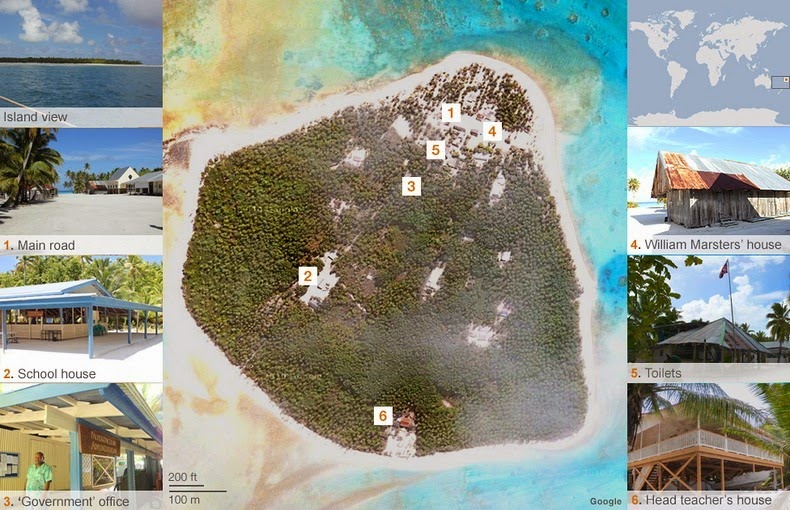
Islanders: William Marsters and his brood. Photo credit

Willima Marsters’ gravestone. Photo credit
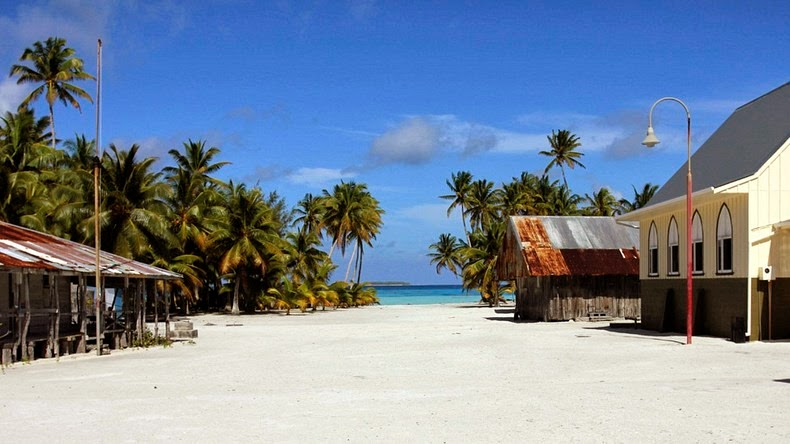
Satellite telephone and solar panels. Photo credit
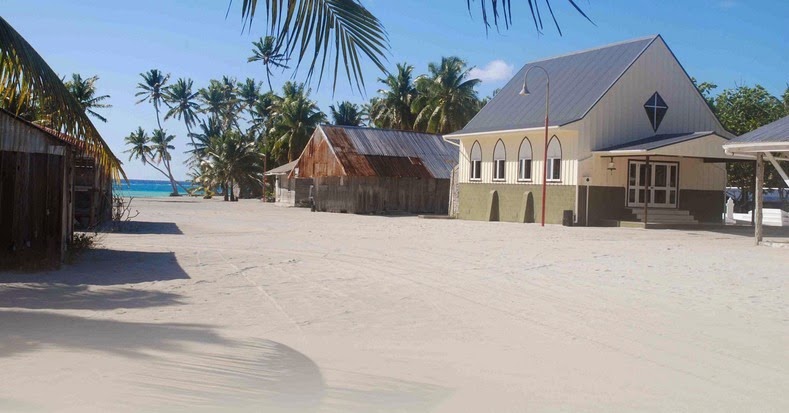
Sources: Wikipedia / National Library of New Zealand / Cookislands / Wikitravel / Palmerston Island
Looks like a calm. peaceful place to relax and get away from cellphones.
Wait until you get to hell to make the comparison
What an odd life they must have. How hard do they work? Do they have any art or culture? Gossip or everything already known about each other?

"Art" and "culture" are largely figments of your imagination. A less childish mind realizes the BS factor of living there must be MUCH lower. And no rap music hopefully!
this must making dating awkward, no?
The same situation can be found much closer to home. Tangier Island, Va.
Hardly. Tangier Island has an airport, consistent electricity and plumbing.
For about a week, maybe. How people live out their lives in such a place is beyond me.
PARADISE!!! give me a one way ticket

Post a Comment
More on amusing planet.
{{posts[0].title}}
{{posts[1].title}}
{{posts[2].title}}
{{posts[3].title}}
Advertisement, featured articles, top countries.
Plan Your Trip to Palmerston Island: Best of Palmerston Island Tourism

Explore Palmerston Island
Palmerston Island

- 3 See and do
- 8 Stay safe
Palmerston Island is a coral atoll which includes five small island groups. It is one of the Southern Cook Islands . It has no airstrip; access is by sea only. It is famed for its hospitality to yachts, and is sometimes compared to Pitcairn Island as they are both remote islands supporting small English-speaking populations.
Get in [ edit ]
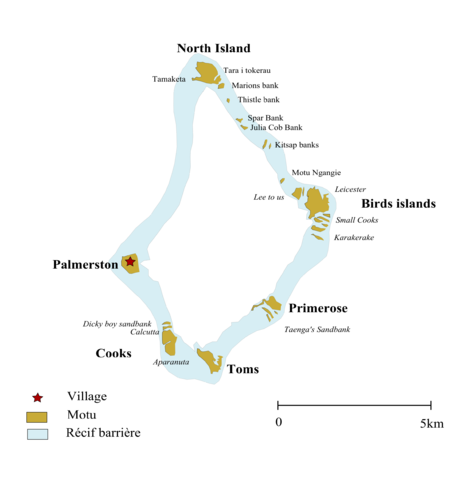
Most visitors arrive by private yacht, and the island sees about a dozen visiting boats a year. There are supply boats that arrive two or three times a year. You could probably arrange to travel on one of these but bear in mind you would be stuck until the next one arrives.
It is generally best to arrive during the daytime. The islanders can then see you approach and will invariably scramble to be the first one to meet you offshore in one of their boats. You will need the assistance of the islanders if you intend to anchor inside the lagoon as the passage is narrow and quite treacherous.
There is a telephone service to Palmerston and it would probably be a good idea to call before arriving. Often the islanders will want specific goods or people brought over and they will be very grateful to you if you can oblige, particularly if you are able to pick up their mail from the Rarotonga post office.
Talk [ edit ]
English is universally spoken, with a distinctive West Country accent. This is the legacy of William Marsters, the original settler of Palmerston, who populated the island with the assistance of his three Polynesian wives. The current generation of Islanders are his descendants.
See and do [ edit ]
There is plentiful fishing in the lagoon and amongst the islands. There are also many islands in the various groups that are beautiful and well worth exploring.
No visit is complete without a game of volleyball with the islanders.
Buy [ edit ]
Eat [ edit ], drink [ edit ], sleep [ edit ].
By custom, the family that first greets you will offer you a homestay at their house. If you are looking for a resort hotel, you are decidedly in the wrong place!
Stay safe [ edit ]
Sailing conditions are rough at the best of times. Monsoon and hurricane seasons can be extremely wild. Do not attempt to navigate to Palmerston unless you are an accomplished sailor.
Respect [ edit ]
The Palmerston Islanders are honest, hardworking and dedicated people. They have great respect for their religion and traditions; however, they are not morbidly religious and enjoy a good party as much as the next man.
The islands are remote, and the telephone service provides its only link with the outside world. If you visit you should try to bring some gifts. Petrol is appreciated, and reading material and fruit are always eagerly received.
As with any small community, there is tension between the three main family groups. As a visitor you should take care to avoid any gratuitous comments relating to the internal politics of the islanders.
Go next [ edit ]
- Has default banner
- Has Geo parameter
- Southern Cook Islands
- All destination articles
- Outline cities
- Outline articles
- City articles
Navigation menu
Palmerston Island - A Coral Atoll In The Cook Islands
A huge lagoon surrounds Palmerston, which is shaped like a delicate necklace in the Pacific with a coral reef, white beaches, six sand Motus, and a coral reef strung throughout. Although the tiny islands of Palmerston, North Island, Lee To Us, Leicester, Primrose, Tons. Cooks have a combined land area of just around one square mile, the coral reef, which surrounds a stunning blue lagoon with a width of seven miles, is nearly 3,600 acres.
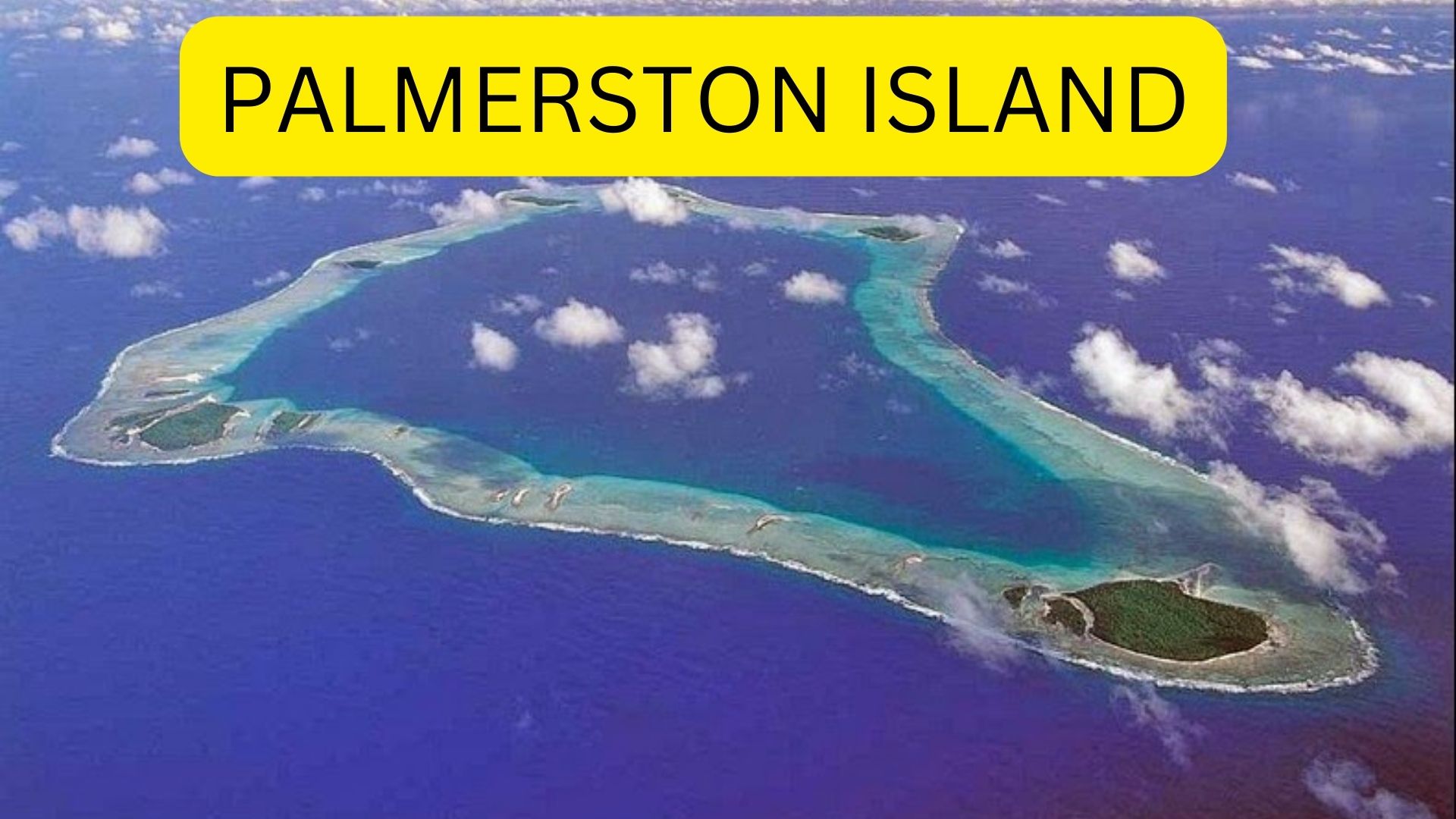
.bwwcfb-y51p0m{color:inherit;font-size:inherit;-webkit-text-decoration:none;text-decoration:none;text-decoration-thickness:1px;}.bwwcfb-y51p0m:hover{-webkit-text-decoration:underline;text-decoration:underline;}.bwwcfb-y51p0m:hover::after{content:" #";opacity:0.6;-webkit-text-decoration:none;text-decoration:none;} History
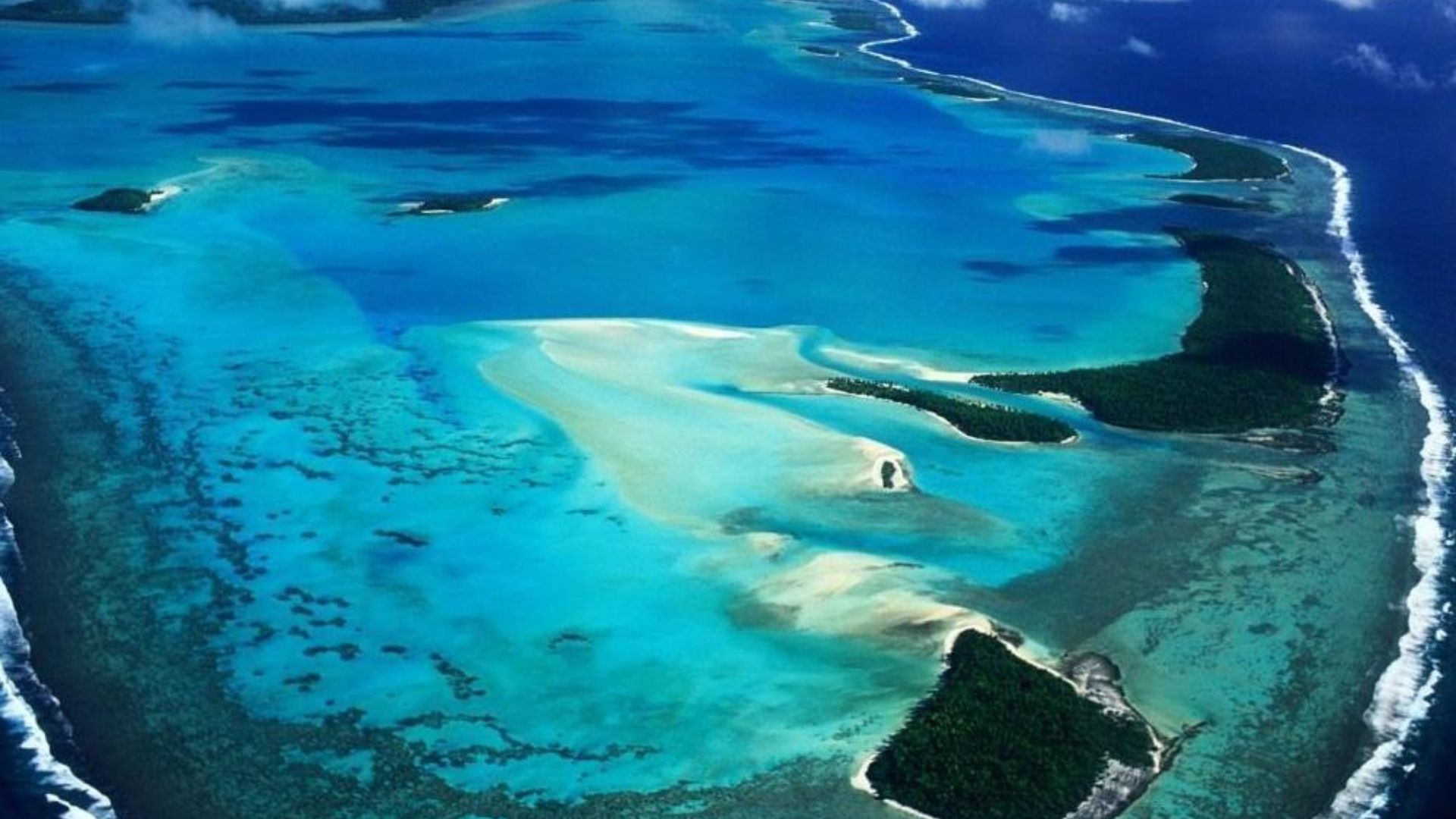
More About Palmerston Island

Palmerston Island, One Of The Most Remote and Beautiful Places In The World!
Elegant And Affordable
People also ask, can you live on palmerston island, can you visit palmerston island, where are the palmerston cook islands, .bwwcfb-1mysgrz{display:-webkit-box;-webkit-line-clamp:1;-webkit-box-orient:vertical;overflow:hidden;-webkit-line-clamp:2;} history.
Plan Your Palmerston Island Holiday: Best of Palmerston Island

Explore Palmerston Island
OUTSIDE FESTIVAL JUNE 1-2
Don't miss Thundercat + Fleet Foxes, adventure films, experiences, and more!
GET TICKETS

Welcome to Palmerston Island, Population 35
Reachable only by boat, this remote Pacific atoll is inhabited by descendants of a footloose Englishman. The idyllic vibe is unmistakable, but it's tested by the realities of living in a very vulnerable place in a warming world.
Heading out the door? Read this article on the Outside app available now on iOS devices for members! >","name":"in-content-cta","type":"link"}}'>Download the app .
When our 38-foot sloop approached Palmerston at dawn one September morning, more than 200 miles from the nearest speck of land, we’d been staring down squalls on the South Pacific for five days and nights. We hadn’t seen a soul since departing from Bora Bora 800 miles ago, but we knew we were close when we noticed the phrase “Kiss My Arse Rock” on the chart plotter.
I had jumped on Serena three weeks earlier to help my dad, a seasoned amateur sailor, crew a zigzagging passage of roughly 1,500 miles from French Polynesia’s Society Islands to Tonga. Joined by a third crewmate, Mason, an olive-skinned 22-year-old, we decided to make Palmerston our stopover in the Cook Islands, based on the hearty recommendation of two fellow California sailors we’d befriended. Per our cruising manual’s instructions, we had e-mailed our potential host, Edward John Dick Marsters, and quickly heard back that we would be welcome—especially if we brought tobacco.
Now, as we near the barrier reef encircling the atoll, an outboard-powered aluminum skiff approaches, carrying three middle-aged men. A sturdy islander clad in a rust-colored Budweiser tee and Lilliputian purple shorts guides the dinghy close. He helps us tie onto a mooring ball anchored on the coral shelf before introducing himself as Edward Marsters, chief of police.
Ed and his brother, Goodley Marsters—Palmerston’s agricultural inspector—stay aboard the dinghy, fending it off Serena ’s carbon hull, while the customs officer, Arthur Neale, boards our vessel . Ed winces slightly as he gingerly flexes a knee. “Too much judo,” he explains through a bushy salt-and-pepper mustache.
This is a place where the traditional advice for cyclones is to lash yourself to a coconut tree on Refuge Hill, the island’s high point at just under 20 feet.
Arthur is a sprightly sailor who turns out to be the son of a Palmerston woman and Tom Neale, a now deceased Kiwi known for living as a hermit on the Cook Island of Suwarrow, just to the north. He sits cross-legged on the deck, carefully pinning down our documents so they don’t flutter away as he scribbles on the immigration forms.
The shallow channel through the reef is impassable for yachts, so my dad, Mason, and I are invited into the skiff to go ashore. The men from Palmerston chivalrously use a life jacket to protect me from spray as we navigate the waves roiling over the rocks. A series of anchored sticks guide Ed through the deepest part of the pass, but I get the sense that any of these men could find their way through with their eyes shut. Though the wind must be blowing at more than 20 miles per hour, Ed pauses, and the five of us watch him roll a cigarette.
Looking back over his shoulder at Serena bouncing on her tether just outside the surf, my dad asks how often the winds turn westerly—a potential catastrophe, since the only moorings are on the west side of the reef. “When they turn west,” Ed deadpans. This is a place where the traditional advice for cyclones is to lash yourself to a coconut tree on Refuge Hill, the island’s high point at just under 20 feet.
Safely inside the lagoon, we clamber out, splashing ankle-deep into warm, limpid water. Dad and Arthur help Ed drag the boat ashore as Mason, who’s been nursing some kind of infected insect bite on his knee, hobbles in behind me. We follow Ed across the sand, studded with sharp fragments of coral, and into the trees to his brother’s house.
Nearly 2,000 miles northeast of New Zealand, Palmerston is 500 miles away from the Cook Islands’ capital and main population center, Rarotonga. The atoll has no airport or any commercial service by sea, but if you can get there, the islanders are happy to host visitors, usually in exchange for gear like nautical hardware and rope. Most cruisers bypass it in lieu of the Cooks’ southern group, since there are no supplies for sale here. Nevertheless, Palmerston gets several hundred visitors each year, during a dry season that lasts from May through October. Often relegated to a mere paragraph or two in guidebooks, Palmerston is known more for its unusual human history than its natural beauty, but it has plenty of both.
In the early 1860s, an English itinerant named William Masters arrived on the island, part of a wave of European missionaries and traders who flocked to Polynesia in the 19th century. Although the Cooks became a British protectorate in 1888 and were eventually annexed by the colony of New Zealand in 1900, the archipelago was politically sovereign when Masters was sent there by an employer to plant palm trees for copra, a form of dried coconut from which oil can be extracted.
Masters had left England for the American goldfields in his early twenties and spent the subsequent years plying the South Pacific, working jobs thought to range from carpenter to interpreter. He came to Palmerston by way of Penrhyn, an atoll in the northern group of the Cooks. There he married a chief’s daughter named Akakaingaro , who he called Sarah. He brought her to Palmerston, as well as her cousin, Tepou, who is recognized as his second spouse, though Masters had previously fathered children with a third woman from Penrhyn named Arehata. Between those three and his third official Polynesian wife, a Penrhyn native named Matavia, Masters sired 23 children. (He also sired several before leaving England.) Today almost everyone on Palmerston can trace their roots back to Masters, with some influx from other islands.
While polygamy was not unusual in Polynesian cultures, Palmerston’s history is unique. Even on Pitcairn—the isle between French Polynesia and Easter Island that was famously settled by the mutinous crew of the Bounty in 1790—at least four original families have yielded its present-day population of about 50.
It’s difficult to understand why an expat would choose to live out his days in such a sequestered locale—until you go to Palmerston yourself.
Masters was well suited to being a patriarch. Known to this day as “Father” by his distant descendants, he instituted marriage policies and other forward-thinking practices that are still in effect, like an annual bosun bird hunt, his take on the Cooks’ traditional ra’ui conservation culture. On the first Saturday of June, the islanders catch enough fowl to give each person exactly half a bird. Hunting the long-tailed white seabirds outside of this ritual is forbidden, a way of ensuring that healthy flocks exist in the future. Masters’s fears about food supplies were legitimate: despite his conservationist attitude, he died on Palmerston in 1899 from malnutrition, a fairly common fate at the time.
It’s difficult to understand why an expat would choose to live out his days in such a sequestered locale—until you go to Palmerston yourself. Windswept coconut trees arch over screen-saver-blue waters and bone-white sand. A ring of named but uninhabited auxiliary islets, called motu, complete a circuit around the seven-mile-long saltwater lagoon, shielding it from the open ocean that surrounds the atoll.
All of Palmerston’s residents live on Home Island, the largest in the atoll, which is less than a mile long. The three main maternal families retain their own areas (in addition to their own motu), with descendants of Masters’s first Polynesian wife, Akakaingaro, residing on the desirable interior.
Thanks to a combination of fishing, rainwater-catchment systems, and a solar generator, the community is largely self-reliant. But there are obvious downsides to this. Palmerston is far from modern medical facilities, and there are undercurrents of tension about the costs of isolation. For years, industrious types from New Zealand have tried to build an airport on the atoll. Some balk at the suggestion, worried that another pristine environment will be polluted and overrun with tourists. But easier access to the outside world is a tempting proposition—especially in light of the climate crisis , which unduly affects low-slung island nations like the Cooks. An airstrip could be the lifeline Palmerston needs to get emergency support in the wake of a natural disaster.
It’s a double-edged sword: an airport would have the power to both shore up Palmerston’s greatest vulnerability and destroy the atoll as it currently exists.
Thick stands of coconut and mahogany trees shelter a home we're approaching from robust mid-Pacific gusts. Pigs and chickens wander freely under a green awning that appears to be an old parachute, supported by the aluminum mast of a ship that ran aground. The battered hull still rests near the beach.
Simon, Ed's older brother, is waiting for us, casually swinging a machete by his side. He’s shirtless, and a potbelly protrudes slightly over the top of skintight navy swim shorts. His pale, kindly eyes are striking against his dark complexion as he invites us to sit where a table is laid for lunch.
Simon’s adoptive adult daughter, Terupea, tends to his 88-year-old mother, Tuine, inside the house. She sits chairbound and mute while the rest of us settle at the table outside. Terupea’s husband, Will, a schoolteacher on the island, joins us. A shrewd Kiwi, he settled on Palmerston in 2015 to help a friend renovate a house. He’d already visited twice, both times en route to Suwarrow, having been inspired by Tom Neale’s 1966 memoir about his experiences roughing it in the Cooks, An Island to Oneself . Will married Terupea in 2018 and is now building them their own home on the north side of the island.
It’s warm but threatening to rain as we drink sweet tea and devour curried chicken with potatoes, peas, and green beans. Although the islanders grow a few crops in small quantities—they harvest starchy staples like taro and sweet potatoes and rely on trees for breadfruit and star fruit—the soil is poor, and most of what’s eaten comes from the sea. They fish for black jack and parrotfish, both crucial for sustenance. The latter is exported throughout the Cooks as well.
“We have more than enough fish for our own diets,” Will says, explaining that other islands’ lagoons are affected by ciguatera , a naturally produced toxin that can render seafood inedible. “Demand for reef fish is insatiable in Rarotonga and Aitutaki.”
To supplement the Palmerston diet, they raise pigs and chickens, and a supply ship comes through every few months from Rarotonga, carrying luxuries and goods like rice, sugar, and lamb from New Zealand.
I ask Arthur, a New Zealand national who’s lived on Palmerston since 2009, how he wound up here. “Like everyone else,” he replies. “By boat.”
As we eat, Will regales us with a story about visiting another island, Niue, after having been on Palmerston for months. Approaching it in a boat, he saw what he assumed were the glinting eyes of animals visible onshore. “I resolved that I would not make landfall until I figured out what they were,” he says. “Soon enough I realized they were cars! It had been so long since I had seen a car that initially it did not dawn upon me what I was looking at.”
Despite their remote location, our hosts are able to keep up with current affairs abroad via Wi-Fi. The Cooks are politically associated with New Zealand, meaning that Cook Islanders are automatically granted Kiwi citizenship and can move freely back and forth. Many of the young adults on Palmerston, like Ed’s son David, have lived in New Zealand to work for a while before returning home.
Aside from exports, government jobs are the primary source of income on Palmerston. Three family heads and an equal number of deputies form the Island Council, the local governing body. The national government also compensates Ed for his duties as the constable, for example, and Arthur for his customs work.
After lunch, David gives the three of us a leisurely tour. Ambling past the crude structures that line the main street of the village, we learn that his family is descended from Tepou, Father’s second wife. He points out a sandy graveyard, where nearly every tombstone is inscribed with the surname Marsters. (The r is a phonetic addition derived from Masters’s rural English accent, which you can still hear reflected in the curious Palmerston pronunciation of some words.)
Peering at Father’s grave, I see his death date and age, 78—though that figure is thought to be off by as many as 11 years—followed by an inscription in Maori and one in English: “Blessed are the dead which die in the lord.” What’s not included is the rest of the biblical passage. “That they may rest from their labours,” it goes, “and their works do follow them.”
The next morning at nine, Ed comes out to Serena , where we’ve spent the night, to ferry us back for the most important social event on the island: church. Nearly every one of Palmerston’s 35 residents is in attendance. Ed is looking dapper in gray slacks and a matching button-down—but no shoes.
Following an hourlong Protestant service with roof-rattling hymns in both English and Maori, we return to Simon’s and feast on grilled lamb and potato salad before convening in the shade in front of Ed’s house, 100 feet away. I notice that one of the cracked plastic chairs is braced with a scrap of plywood.
“It’s a day to rest,” Ed says, as a fuzzy replay of last night’s All Blacks rugby match blares from a television inside. Two Union Jacks hang by the TV.
By this point, Mason’s knee is so swollen that it’s shiny, and he can barely bend it. Though it’s the Sabbath—no one is even supposed to swim on Sundays—Ed phones the island nurse, Sheila, who makes an exception and does a house call. She declares it a boil and administers antibiotics free of charge.
The prospect of more convenient health care is a bargaining chip that’s long been used by proponents of the airport. Still, the islanders have historically vetoed development. Only one dissenter is necessary to halt the project, and last time around, about a decade ago, one of the families voted against it: Ed and Simon’s. Ed told me their mother had gestured skyward and said, “Doctors do not hold my life. God does.”
Located on one of the motu—the trees razed—the airstrip would desecrate Palmerston’s natural resources. “Think of the lagoon in one year,” Ed says, comparing the potential effects of tourist infrastructure to the rampant pollution in Rarotonga.
There are cultural reasons for rejecting development, too. The languorous island way of living would not—could not—exist as it does. “We would not be sitting here now,” says Ed, gesturing at our impromptu circle. According to him, he was largely thinking of future generations when he opposed the airstrip. “But if my great-grandchild wants it…”
But Ed is losing ground. Despite the fact that South Pacific countries like the Cook Islands account for less than 1 percent of our planet’s greenhouse-gas emissions, sea levels are rising even faster in the Cooks than the worldwide average. The ocean is acidifying —a detriment to coral reefs and the sea life they support—and rainfall patterns are becoming more erratic , undermining traditional farming and water-capture practices. Meanwhile, cyclones, which can not only damage infrastructure but also erode invaluable land via storm surges and flooding, are predicted to decrease in quantity but worsen in severity, facts that are all the more troubling when you’re as far from aid as Palmerston is.
“It’s almost like, ‘Hi, guys, you need to do this and that,’ without the acknowledgement that it was not the people of Palmerston who stuffed the environment up.”
Tropical hurricanes have hit Palmerston as recently as 2016, with really damaging ones occurring only a few times per century. The island just built a new cyclone shelter with funding from the Japanese government, but if a storm does hit hard, it could be back to ground zero.
On a national level, the Cooks are taking basic steps to preempt the effects of global warming, like improving water-capture systems in anticipation of droughts and installing and upgrading weather stations to help fishermen and farmers get reliable, real-time information. Although the United Nations Adaptation Fund has poured $5,381,600 into projects like this, it’s a small comfort when a major storm is bearing down on you and your family.
“Ease of access would greatly benefit the Palmerston people,” Will says. He understands each side of the debate, though. “The more we expose ourselves to the outside world, the more we have to worry.”
For Will, the biggest threat to Palmerston is reliance on modern conveniences. “We are slowly losing our traditional subsistence techniques,” he explains. “Climate change will affect food production elsewhere, and in the face of resulting unaffordable prices, we will have no resort but to return to our traditional basic agriculture and foraging. If we have lost those skills, then a remote atoll can be very unforgiving.”
When I ask him if he worries about more acutely destructive crises, like severe cyclones, he gets defensive. “It is very easy to sound like a propagandist when you are talking about climate change to someone who has no motor car and catches fish with a palm frond, including myself,” Will says. “It’s almost like, ‘Hi, guys, you need to do this and that,’ without the acknowledgement that it was not the people of Palmerston who stuffed the environment up.”
Ultimately, he concedes that Palmerston’s way of life is fragile. “We try not to worry about it,” he says, “but we realize our vulnerability.”
As long as there’s a vestige of nonconformity on the island—someone like Ed, who’s willing to do things his own way, for better or worse—daily life on Palmerston will remain much as Father experienced it. Until the last holdout caves, there’s little that can change the fate of the atoll. So for now, we content ourselves on our wobbly plastic chairs, trying simply to enjoy the breeze as William Masters might have.
- Climate Change
- Environment
- French Polynesia
- New Zealand
When you buy something using the retail links in our stories, we may earn a small commission. We do not accept money for editorial gear reviews. Read more about our policy.
- Relationships
Nothing Goes Wrong on Palmerston Island
This New Zealand protectorate is one of the most isolated communities in the world. Palmerston Island is the westernmost islet of a coral atoll belonging to the Cook Islands in the Pacific Ocean. Just sixty two people – all from the same bloodline – occupy the remote island, which sits approximately 2,000 miles (3,200 km) northeast of New Zealand and 2,850 miles (4,590 km) southwest of Hawaii.
While the enclave is an island utopia, paradise comes at a cost: Palmerston lacks an airport, gas station, grocer, and hospital. There are no cars, marinas, hotels, or restaurants. Yet despite this lack of amenities, one family has managed to prosper on the island for over one hundred and fifty years.
Palmerston Island is located on the summit of a submerged ancient volcano (also known as an atoll ) which rises 13,123 feet (4,000 m) from the ocean floor. The atoll is composed of more than a dozen sandy motu (coral islets) which loosely form a ring along a coral reef and enclose a lagoon.
The largest of the motu are North Island , Leicester , Primerose , Toms , Cooks , and Palmerston – the last being the only permanently-inhabited island of the atoll. The islets are wooded with coconut palms and pandanus, and together they cover about one square mile (2.6 km 2 ) of land.
The atoll’s lagoon measures seven miles (11km) across and spans 22 square miles (56km 2 ). The coral reef occupies 5.6 square miles (14.5 km 2 ) and protects the islands from large ships: Over the years hundreds of boats have struck the coral formation hiding just below the surface.
Access to Palmerston is limited. The island lacks an airport and the reef is too near the water’s surface for sea planes to land. Helicopters don’t have the range. Boats are the only option, but the island has no harbor and a treacherous approach which has taken the residents a lifetime to master.
Traveling to Palmerston Island by ship can take 8-9 days, and during that time travelers will not see land, encounter another boat, or see a plane in the sky; for a week it feels as if you are the only beings in the world.
(click thumbnails to enlarge)
courtesy Patrick Dayshaw & Kirsten Rohrbach
Explorer James Cook (left) is credited with the modern era discovery of the islands, and as a result they bear his name today.
On June 16 th , 1774, during his second Pacific voyage, the captain’s ship first observed Palmerston – but he would not set foot on the island until his third voyage on April 13 th , 1777. Cook named the islet for Henry Temple, 2 nd Viscount Palmerston, Lord of the Admiralty .
After Cook disembarked from the atoll, the remote motu did not witness human occupation for more than eight decades. When Englishman William Marsters encountered Palmerston in the mid-nineteenth century, he immediately fell in love and sought to take up residence.
At the time Palmerston Island was owned by British merchant John Brander, who would later appoint Marsters caretaker. The arrangement was symbiotic: While living on the island Marsters planted, grew, and harvested coconut trees.
Every six months Brander would send a ship to the island with food and supplies. Marsters would send coconut oil back.
William Marsters
[ Marsters was born “William Masters.” His name is thought to have been corrupted through pronunciation over time. ]
William Marsters would tire of his journey, and as one version recounts, he would disembark in 1859 when the ship stopped in Tahiti. During his time there, he became acquainted with Tahitian-based trader John Brander, then-owner of Palmerston Island.
When Brander’s island caretaker quit, he reached out to Marsters, who by this time was on another Cook Island: The once-populated Manuae ( now abandoned – map ).
When Marsters arrived on the island as caretaker in 1863, he was accompanied by three Polynesian wives (the second and third were cousins of the first). This resulted in a unique domestic arrangement which split the island’s population between multiple families who still populate the island today: the Tepou , the Akakaingaro , and the Matavia .
Marsters divided the island into sections giving himself and each wife their own space. He then spent years building a community using salvaged timber from shipwrecks.
The first structures were homes for each family, followed by a church and then a schoolhouse. Marsters house featured the most robust construction; pilings salvaged from three different ships sunk over 10 feet (3m) into the ground have helped keep it intact for more than a century (above) .
Marsters’ home was described in a New Zealand newspaper dated 1894:
The timber, excepting being cleaned and in some instances planed, was used just as it came from the wreck. The result is that he has rafters 24 by 24 ; ridgepoles, 12 by 12; uprights, 18 by 12 and 18 by 24 ; door posts, 24 by 24; while the boarding of the houses and the flooring are of 12 by 4 and 4 by 3, resting on timbers 18 by 12 and other light pieces of timber. The doorsteps are of 18 by 12 and 20 and 25 feet long. The nails used in the houses are ship’s bolts.
In 1888 William Marsters laid claim to Palmerston Island after owner John Brander passed away. The claim was contested by Scotsman George Darsie, a relative of Brander who argued for inheritance via bloodline.
Marsters would ultimately emerge the victor when Queen Victoria granted him possession of the island by way of a 21-year lease .
For 36 years William ruled over his parcel in the Pacific, but the limited resources eventually took their toll. When his coconut trees were destroyed by blight in 1899, the 78 year-old Marsters fell ill and died of malnutrition on May 22 nd of that year.
The island’s founding father was laid to rest in the church cemetery, his grave marked by a monument today ( below left ). Marster’s three wives are nearby, buried together in a crypt in the cemetery ( above ).
[ After the time of Feodor Vassilyev – but before Calvin Murphy – there was William Marsters, who fathered 23 children and had 54 grandchildren before his death.
Click here to see a list of people in history with the most children. ]
Today the island is administered by the Cook Islands government – through the Palmerston Island Administration (PIA) – in association with New Zealand.
Despite today’s New Zealand territorial governance, the residents appear to embrace and identify more with their British heritage.
Pictures of the Queen adorn walls of the homes, and on special occasions the British flag is flown.
[ An article in Australia’s ‘Melbourne Argus’ dated April 16th, 1888 describes a ship’s experience as they sailed past Palmerston:
“There were 33 persons on the island. Marston (sic) had married a half-caste kanaka woman and was the father of eleven sons and four daughters. All the islanders speak English fluently and the family appears to live on the happiest of terms.” ]
Life on Palmerston
Today homes have their own water supplies via individual plastic cisterns, however after several months the personal water catchments usually run dry. When this happens, the community reservoir is used.
Life on Palmerston offers many things, but none of them are a variety in diet: Atoll delicacies are limited to coconuts, parrotfish, shellfish, and wahoo – and that’s to say nothing of the “ Bosun Bird ” ( or red-tailed tropic bird ).
However if residents want to go to the bathroom they must go outside, because Palmerston homes don’t have indoor plumbing.
Despite only two restrooms, queues haven’t been an issue. In other news, coconuts are high in fiber.
“Welcome to my world, a land of white sands and coconuts. Nothing goes wrong in Palmerston.”
-Bob Marsters, mayor
There are two main streets, and they’re dirt, but they have street lights. There are no shops or grocery stores.
Rations are limited to what residents are able to catch. Ergo, when they are not hosting visitors, fishing occupies most of the day for men on the island. Women teach, fashion clothing and jewelry from materials sourced on the islands, and prepare food for meals and storage.
A favorite dish is parrotfish, baked in a traditional umu oven and served with a homemade broth of salt-water and coconut milk brine. They assure it tastes better than it sounds.
On the 28 th day of the month, from June to September, the Palmerstonians cull the full-grown Bosun birds from neighboring motu in the atoll. This schedule of limiting Bosun harvesting was brilliant foresight by William Marsters to ensure preservation of the seabird population.
Less successful have been the attempts to sustain the parrotfish population, which has seen a decline due to overfishing. In the 1990s the island council attempted to put a two-year ban on the catching of parrotfish, but the need for food and money forced residents to break the rule just months into the ban.
“All the people fighting wars should just come to Palmerston and go for a swim, play some volleyball. No need for all that fighting and killing everybody, no-one fighting here.”
– Bob Marsters, mayor
Palmerstonians are passionate about religion. Ever since English missionary John Williams converted William Marsters to Christianity in the 19th century, island residents have not been allowed to do much on Sunday except go to church.
The original church was destroyed in a 1926 typhoon; it was rebuilt years later and today it stands as one of the newest (and sturdiest) buildings on the island.
The church bell was originally a ship’s bell, salvaged from the shipwreck of the Thistle (left) .
Generally life on Palmerston appears to be good. As Mayor Bob says:
“You are free to do what you want to do.”
Kids love to play “hit, bat, run,” a game suspiciously similar to baseball. In the afternoon some will go swimming and others play volleyball. A group of men gather around the satellite TV to watch rugby while the women relax on hammocks by the beach.
The only thing missing is alcohol: Until the next freighter arrives, the island is dry.
Visiting ships are hosted by one of the Marsters families, who take turns hosting each guest. This includes assistance with mooring, the ferrying back and forth between the boat’s place of anchorage and Palmerston, the feeding of visitors, and tours.
However don’t expect a free lunch; the people are kind but they don’t offer such hospitality without getting something of value in return.
If you do visit Palmerston, come prepared as it is custom for the host to receive goods or services from the guests in exchange for the hosting.
Palmerston’s remote location makes it difficult to maintain a trade or currency market, limiting the islet’s capacity for economic growth.
The atoll’s “industry” is limited to fishing, tourism, and copra , with fish being the island’s only significant export.
[ Usually rarely visited, Palmerston attracted an unprecedented 108 boats in 2010. ]
Freighters collect frozen parrotfish from the island in exchange for food and supplies such as rice and fuel. Parrotfish prices fluctuate, but on a good day Palmerstonians can fetch between $3 and $5 per pound.
Working against the Palmerstonians is the lack of a consistent and reliable distribution network, which hampers the island’s ability to get products to the marketplace.
Residents repay supply ships with hospitality and fish when the vessels steam through every six months – if they come at all.
A few years ago a freighter didn’t come for 18 months, according to current Mayor Bob Marsters. The islanders survived, but resources were exhausted and tensions were high.
“The day the freighter arrives it’s like Christmas Day.”
– Mayor Bob Marsters
Employment options on Palmerston are understandably lacking. The island boasts just three government-sponsored positions, none of which experience turnover:
- Diesel generator operator: Manages generator that powers the lights and nearly two dozen buildings.
- Teacher: The “ Palmerston Lucky School ” accommodates students age 5 to 17.
- Customs and Quarantine Administration: Check in visiting boats and cargo ships, collect tariffs.
Palmerston’s population has fluctuated over time, but at its zenith around 300 people managed to coexist on the small island between 1950 and 1970.
Today just sixty two call the island home – a third of whom are children. Elders fear the number may fall with the latest generation showing more interest in leaving to pursue greater opportunities abroad.
[ An 85-year-old woman on the island had fourteen children but lost count of the number of grandchildren. Today just three of her children live on the island, the rest having relocated to Australia and New Zealand. ]
All but two residents are descendants of William Marsters and fall into one of three families.
William had six children with his first wife, a woman he had assumed was his second cousin. However when she was young she was sent to live with another family member. She was, in fact, Bill’s first cousin. Says Bob Marsters today of Williams’ marriage:
“Her father and my father were brothers. I didn’t know it, but by the time we found out it was too late and we already had kids… There’s nobody on the island, that’s why the intermarriage is going on.”
The residents unrelated to Marsters include a Fijian nurse on a single-year residency and a school teacher by the name of Rose Clark, who fell in love when visiting the island on which her father had shipwrecked over fifty years ago.
Important issues are dealt with by Palmerston Island’s council, a six-member panel which consists of two representatives from each family. The etiquette, generosity, legal system, religion, and traditions have all been passed down from generation to generation.
The tension is understandable considering they live with sixty one of their extended family in a confined and isolated space. Disagreements are often benign, and when visitors arrive the hospitality and smiles are usually quick to return.
“They’re such a family-orientated community – it’s very beautiful. I’ve learned a lot about their closeness while I’ve been here.”
– Rose Clark
For more than one hundred years the islanders kept diligent record of council meetings, court proceedings, and official letters. Unfortunately the records were recently lost in a fire at the church where they were stored.
The Cook Islands National Archives in Rarotonga maintains copies of some of the original documents; records show that the Māori language was in use on the island for many decades after settlement.
One 1908 agreement was written completely in Māori and is reproduced here with the original spelling, punctuation, and capitalization:
Oct 21 1908 Palmerstons ‗ 1. E ture teia i aika tika e i aka mana ia e te au Koura e i aka tika ia ei ture tina mou ki te Enua hei te ra taua ture Ko ki Kopara o te enua hei — Ko te papa e inangaro i te Kopara Ka tuku mua aia e rua pau Moni ko te ture ate Kopara Kare rava e akatika ia to Kopara me Kore e tutaki ia teia moni hei 2. Ko te tangata e aka tuke i teia ture hei ka akautu ia aia e rima paunu 5-00 John Marsters Carry James Marsters x Tom Marsters x Aaron Marsters William Marsters.
English translation: “October 21st, 1908 Palmerstons 1. This law is an agreement about the authorization to dry copra and this agreement will hold as law for this island. This is our copra law for this island. — He who requires copra will be granted by this copra law two pound-weight. This agreement will not stand if payment for this is lacking. 2. If any person alters this law, he will be fined five pounds. [signed] John Marsters Carry James Marsters Tom Marsters Aarom Marsters William Marsters.”
Palmerston Technology
Solar arrays charge a battery bank which keeps the island’s communications equipment running. (At right: Palmerston phone booth courtesy Patrick Dayshaw and Kirsten Rohrbach )
The supply ships bring the island gasoline, but the supply doesn’t always last until their next visit. When the generators do have gasoline they are run from 6 a.m. to noon each day, and again at night to power streetlights, small home appliances, and freezers (which keep the fish frozen until the next freighter arrives).
“I don’t get bored here, but I get discouraged. I swim, fish, play guitar, talk – that’s about all.”
– Shekina Marsters, 16
Transportation on the island is generally poor, but really just unnecessary. There are no cars but a handful of mopeds can be spotted. What visitors will see most often are the small boats, owned by nearly every household and a key cog in the Palmerston fishing and tourism industries.
[ When the oldest inhabitant, 92-year-old Mama Aka, went for dental work on Rarotonga, it took her four days to get there. After the procedure she had to wait six months for a ship to bring her back. ]
Two telephones allow the islanders to stay in touch with friends and family around the world, and the recent addition of Internet access thrust Palmerston into the twenty first century – although both are only available four hours a day.
The island’s homes offer more than you might expect: Some have refrigerators, satellite TV, VCRs, and washing machines.
“We were made to enjoy the world, enjoy the fresh air, enjoy the sunshine, enjoy the things God put us on the earth to enjoy. He didn’t put us on the earth to kill other people or hate other people.”
– Bob Marsters
A passage from a book about Palmerston Island by author Susan Casey describes the experience thus:
If heaven were a color, it would be tinted like this. You could fall into this water and happily never come out, and you could see it forever and never get tired of looking. There could be no confusion about who called the shots out here, at this gorgeous, haunted, lush, heavily primordial place, with all its unnameable blues and its ability to nourish you and kill you at the same time.
Did You Know?
• The ancient name of the island was Avarau , meaning “two hundred harbour entrances.”
• Palmerston Island is the only island in the Cook Islands Group for which English is the native language.
• By the time William Marster’s youngest daughter Titana Tangi died in 1973, there were over a thousand of his descendants living in Rarotonga and New Zealand.
• The highest point is only 13 feet (4 m) above sea level; it earned the nickname “the Mountain.”
• Until 1969, the island was misplaced on maps since Captain Cook’s original charts had misidentified the exact location of the island by about 10 miles. Satellite technology eventually corrected Cook’s centuries-old error.
• Palmerston is the only true atoll in the southern Cooks group .
• For the Marsters story in more detail, click here .
• Since no Polynesians were living on Palmerston when William Marsters arrived, it is the only island in the Cooks which has never operated under traditional Polynesian system of Ariki ( chiefs ). The later discovery of primitive tools, several basalt adzes, and 12 ancient graves leads some to believe the atoll had been inhabited long before Cook discovered it.
• Pacific Expeditions operates M/V Bounty Bay , a sport and tourism vessel with routes to Palmerston from Rarotonga. Guests on PE ships can enjoy diving, eco-adventure, and underwater filming.
• In the Palmerston Yacht Club (pictured above) , visitors can purchase Palmerston Island t-shirts and craftwork. There is also a bar – but it has no beer.
• Respect the locals: The Palmerston Islanders are honest, hardworking and dedicated people. They have great respect for their religion and traditions; however they are not orthodox and enjoy a good party as much as the next man. Visitors should consider bringing gifts or supplies. Petrol, reading material, and fruit are always appreciated.
• Palmerston Island is sometimes compared to Pitcairn Island , as both are remote islands supporting small English-speaking populations.
Getting to Palmerston
Access can be obtained through one of the seven designated ports of entry : Rarotonga, Aitutaki, Penrhyn, Pukapuka, Manihiki Tauhunu, Manihiki Tukao, and Atiu . Plan to arrive during daylight, and upon approach contact the Palmerston Administration on VHF Channel 16 or sideband at 1830 utc/4038 MHz .
Clearing fees in Rarotonga are NZ$25 at Customs & Immigration. As of 2014 the only other fees on Palmerston are $5 per person to check in and $10 per night for the mooring. Don’t be afraid to ask Palmerstonians what to bring in advance; often they will request specific goods or people brought over and they will be very grateful to you if you can oblige.
For example, they always appreciate when visitors pick up their mail from the post office in Rarotonga. Gifts of fishing hooks and lures, school supplies, or staples are very much appreciated.Their preferred items are clothes, staple foods like rice and flour, gasoline (as much as you can carry), VHS movies, and educational tapes and toys for the children. Don’t bring alcohol, firearms, or ammunition – but do bring fishing line and tackle.
And of course no visit is complete without a game of round-robin volleyball with the islanders. When visitors depart, the Island Administration issues official “departure certificates” to commemorate the visit.
• Sleep: By custom, the family that first greets visitors will offer a stay at their house.
• Mooring: The moorings at Palmerston consist of chain wrapped around and through small coral heads or anchored under coral flanges. The moorings were originally installed not by the islanders themselves, but by passing ships equipped with appropriate scuba equipment. Moorings are inspected at the beginning of every season. In addition to mooring, vessels drop anchor for additional support to avoid the reef. For additional mooring tips at Palmerston, click here .
• Contact Info: Bill Marsters, Telecom Cook Islands Ltd , Palmerston Office Tel:+682 37 637, Mobile: (682) 76 106 Fax:+682 37683 ,VHF Channel 16 – Call sign: ECHO 5 LIMA – Palmerston Radio. [email protected] ** Palmerston High-res topography map:
- Privacy Policy

Palmerston Island
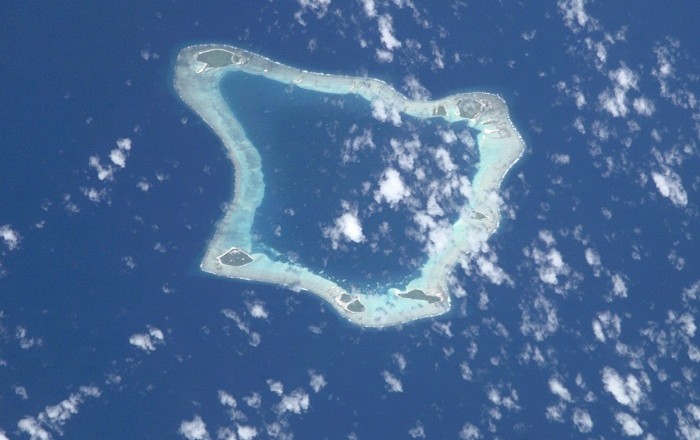
Palmerston Island is a small coral atoll that is located in the South Pacific Ocean, and it is part of the self-governing island country in free association with New Zealand, the Cook Islands. Even though the islands are called the Cook Islands, Palmerston is the only one on which Captain Cook ever set foot himself.
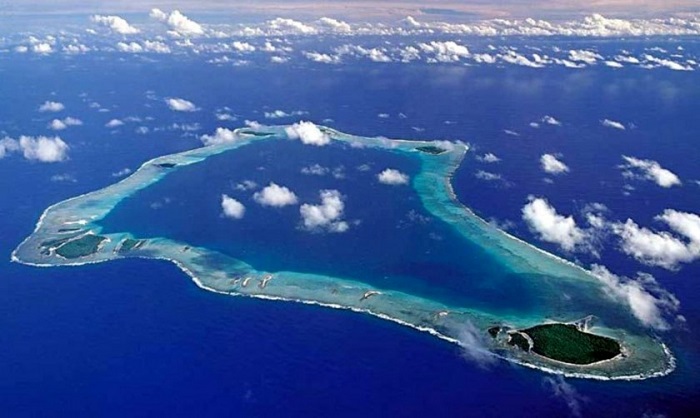
At first, Captain Cook discovered this beautiful atoll in 1774, however, he set foot on it on 13 April 1777, where he found it to be uninhabited with some traces of ancient graves. Today, the Palmerston Island is comprised of a number of sandy islets on a continuous ring of coral reef enclosing a lagoon, and the largest of the islets are Palmerston, North Island, Lee To Us, Leicester, Primrose, Toms, and Cooks.
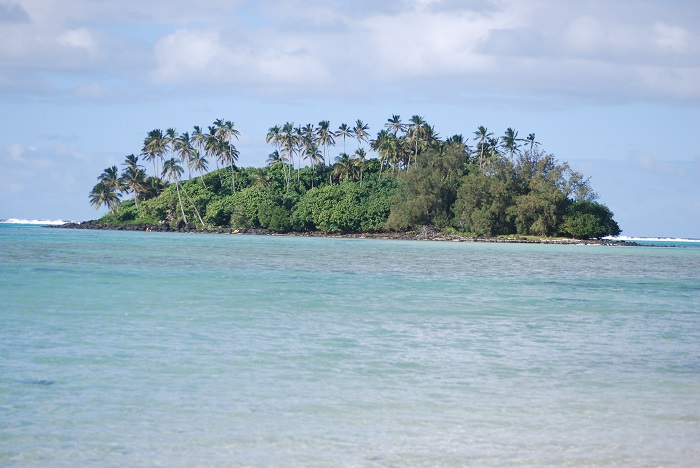
Named after Lord Palmerston who was First Lord of the British Admiralty and father of a future British Prime Minister, it is believed that the first inhabitants of the atoll named it Avarau, which means 200 Harbours. The highest point of the island is some 4 meters (13 feet) above the sea, and the land near the reef is infertile, but there are typical atoll tree crops of coconut and pandamus.
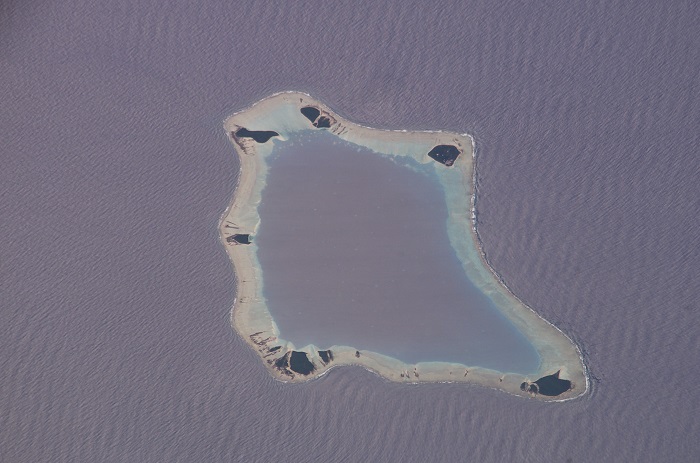
The total land area is estimated to be almost 3 square km (1 square mi), while the lagoon between the islets is around 11 km (7 mi) across, covering an area of 56 square km (22 square mi), and there are several small passages through the reef for boats, though there is no safe entry for large ships. A very interesting fact is that all of the islanders are descended from one Englishman, William Marsters, who arrived from other Cook Island, Manuae, accompanyed by three Polynesian women. It is unclear how many wives he had after the abandonment of his first wife and two children in the UK.
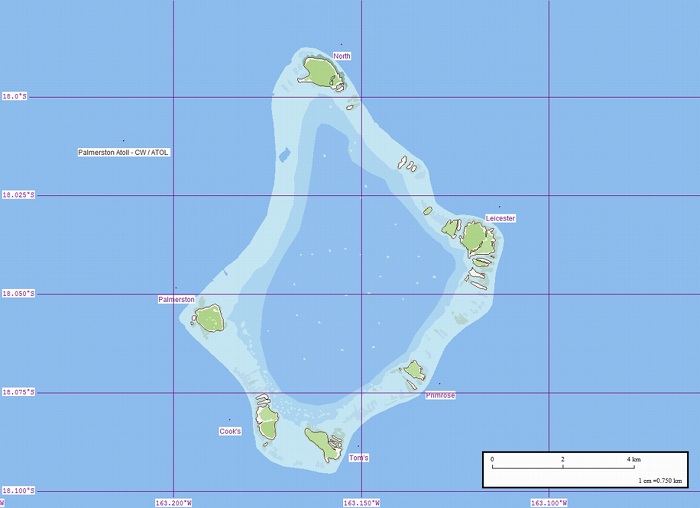
Still, being one of the most isolated islands and community in the world, the inhabitants’ economy is based mostly on fishing, tourism, copra, and bird feathers, though Palmerston’s extreme remoteness makes a cash market difficult to maintain. Nonetheless, their life is being improved, as of 2015 they are no longer dependent from the generator that was producing electricity, as the island came into the 21st century with a round the clock power supply for the first time.
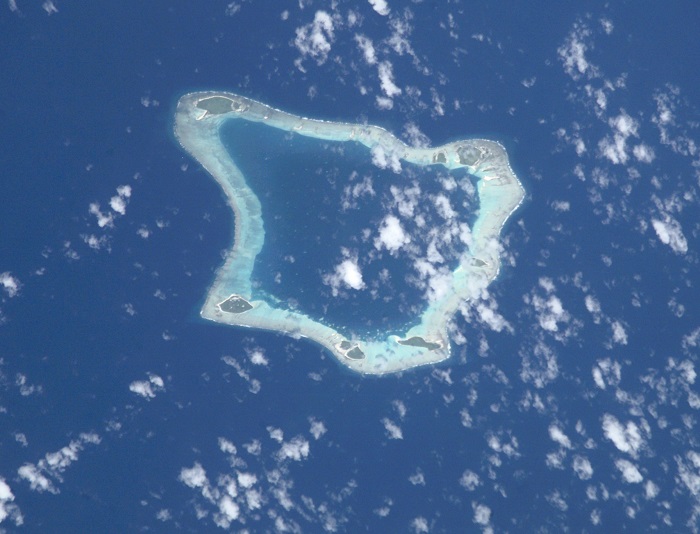
A solar power station was switched on, replacing the diesel generator on which the islanders have depended for decades, and they will no longer continue to wait for the fuel that was brought to them a couple of times in an year, usually from New Zealand.
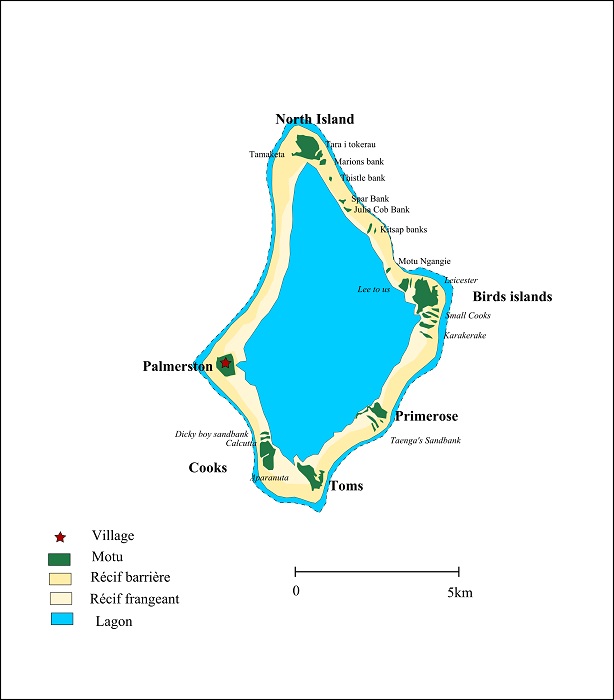
Definitely one of the last not so spoiled paradises on the planet, Palmerston Island shall continue to battle with the growing ocean, with hope that the whole atoll will survive and be well known around the world for the people to be inspired and visit it.
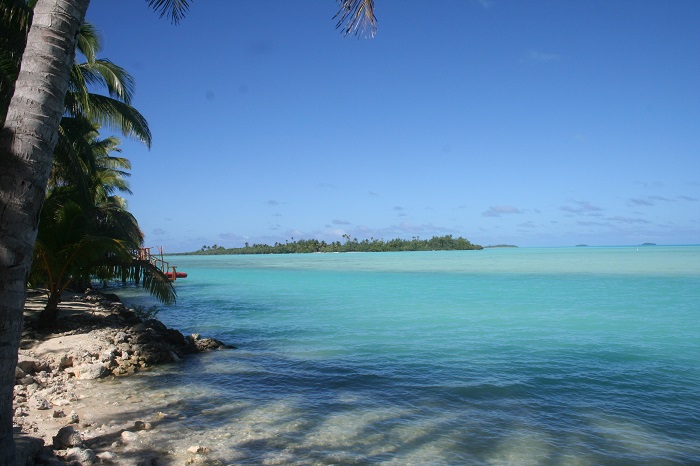
The Adventures of S/V Silhouette
Exploring the world at 6 knots...
Wednesday, September 11, 2013
A visit to palmerston island.
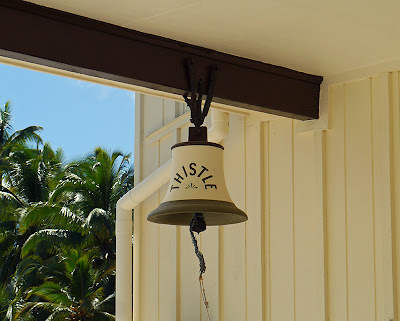
No comments:
Post a comment.
- +1 800-442-4448
- My Account Hello Credits My Account Log out
Palmerston Island, Cook Islands
Recommended for you.
- facebook-official
- youtube-play
- pinterest-circled
The Complete Travel Guide to Palmerston North
Nz pocket guide is 10 years old. thank you for trusting us with your trip for over a decade, a travel guide to palmerston north.
Located on the banks of the Manawatu River, bordered by the Ruahine and Tararua Ranges and a hub for its surrounding farm region, Palmerston North is the prime example of a Kiwi city. Natural playgrounds, whether it’s beach or bush, are never too far away while the community spirit of a farming region is a joy to experience through farmers’ markets and farm tours. The city itself has few attractions worth exploring between the Manawatu River Pathway, with its picturesque gardens and native bird hospital at Victoria Esplanade, and its significant museums, like the New Zealand Rugby Museum and Te Manawa.
So if you’re on a North Island road trip and you’re looking for a stop between the Central North Island and Wellington, Palmerston North provides welcome relief from the lengthy drive, as well as plenty of reasons to make you glad you popped in. Plan your visit with this complete travel guide to Palmerston North.
Fast Facts About Palmerston North
Location : In the centre of the lower North Island in the Manawatu-Whanganui region.
Population : 88,300
Climate : Daily average temperature – 13.3°C/56.0°F , yearly average rainfall – 980mm/38.6 ″ Find out more in What is the Weather Like in New Zealand?
Time zone : NZST / GMT+12/+13
How to get to Palmerston North : Palmerston North is well connected to the rest of New Zealand by road, located on State Highway 3, just a short detour off State Highway 1. The closest international airport is Wellington Airport (2 hours drive) with plenty of car rental options available . It also has a domestic airport with regular flights from Auckland. Palmerston North is also on the main national bus route, which you can find more information about in Bus Networks in New Zealand .
Palmerston North for Budget Travellers
From the city parks to the surrounding landscapes of the Ruahine to Himarangi Beach, Palmerston North offers plenty to explore for free. Combine that with the city’s free and cheap museums and you have an affordable stay in this hub of the lower North Island. As a popular student city, Palmerston North has affordable recreational activities and eateries to match, making it an ideal pit stop for budget travellers. Plan where you’re going to stay, what you’re going to do, and where you’re going to eat in The Guide to Palmerston North on a Budget .
Budget Activities in Palmerston North
- Visit the Te Manawa Museum of Art, Science and History
- Check out the New Zealand Rugby Museum
- Wander through native bush in Bledisoe Park
- Hike in Manawatu Gorge and visit the Te Apiti Windfarm
- Walk or cycle the Manawatu River Pathway.
For elaboration on each experience and more, see the 15 Free & Cheap Things to Do in Palmerston North .
Budget Accommodation in Palmerston North
Palmerston North is a city of motels, many of which offer cheap rates for an affordable self-contained stay. You’ll also find some but limited budget lodges, hostels and hotels. Check out your best options for cheap stays with our 10 Best Budget Accommodation in Palmerston North .
Palmerston North for Luxury Travellers
Palmerston North is your premier city destination for countryside living in the lower North Island. Play on New Zealand’s original golf course, ride among lush farmland on horseback, and visit the city’s surrounding villages and their boutiques. It’s also a place where you can discover new hobbies, perhaps kitesports on Foxton Beach, or simply enjoy the pleasures of doing nothing at all as you unwind with a luxury spa treatment. Stay in well-appointed hotels or one of the city’s nearby luxury lodges. Plan your entire stay fuss-free with The Luxury Guide to Palmerston North .
Luxury Activities in Palmerston North
- Experience sublime scenery on a horse trek at Makoura Lodge
- Tee off at Palmerston North’s premium golf courses
- Do some boutique shopping
- Tackle unique beach sports at Foxton Beach
- Indulge in a luxury spa day.
For elaboration on each experience and more, see the 6 Luxury Activities in Palmerston North .
Luxury Accommodation in Palmerston North
Palmerston North might not be a destination of five-star luxury, but you will find some four-star international hotels in the city, as well as premium boutique lodges on the outskirts. Plan your stay with the 5 Best Luxury Accommodation in Palmerston North .
Palmerston North for Families
Have a stroll around the parks and walkways, check out the indoor activity centres and museums and you’ll likely think that Palmerston North was made for families. The city makes a pleasant break from the road when travelling around the family, offering effortless and affordable fun. At the end of a busy or, if you prefer, not-so-busy day, retreat to one of the many self-catering motels to keep costs low or to a hotel where you can treat the whole family to dinner. Plan the perfect family stay with The Guide to Palmerston North for Families .
Child-friendly Activities in Palmerston North
- Visit the birds at Wildbase Recovery
- Explore the gardens of The Herb Farm
- Take a farm tour of the Robotic Dairy Farm
- Take a road trip to Hikurangi Beach
- Have a splash at the Lido Aquatic Centre.
For more information on each activity and their locations, as well as a few others, take a look at the 10 Things to Do in Palmerston North with Kids .
Family Accommodation in Palmerston North
Convenience is key in Palmerston North, which boasts an array of motels with self-catering facilities and other comforts of home, like laundry facilities. You’ll also find holiday homes and hotels should you be after something different. Take your pick from the 10 Best Family Accommodation in Palmerston North .
Palmerston North for Couples
To New Zealand standard, Palmerston North has a bit of a reputation for not being the prettiest. But with a picturesque river and walkway running through it and places like Victoria Esplanade with endearing gardens, we might beg to differ. The city is an exceptional place for date night with a wealth of quality restaurants while the nearyby beaches and mountain ranges certainly set the tone for romance. Plan your retreat with your loved one using The Honeymoon Guide to Palmerston North .
Romantic Activities in Palmerston North
- Wander around the rose gardens and native bird hospital at Victoria Esplanade
- Road trip north to see dramatic limestone landscape and glowworms at the Limestone Creek Reserve
- Indulge in a couples spa packages at the Hiwinui Country Estate
- Cosy up with a movie and wine at the Focal Point Cinema & Cafe
- Watch the sunset from Himutangi Beach or Anzac Park.
For more information on each experience and others, see the 7 Romantic Activities in Palmerston North for Couples .
Romantic Accommodation in Palmerston North
In the city, the premium hotels and a couple of the more upscale motels provide a romantic stay for couples. Check out some of your options in the 5 Best Romantic Accommodation in Palmerston North .
Palmerston North for Foodies
Where Palmerston North really shines is its food. Foodies will definitely want to make a stop here when travelling the North Island to get an insight into some of the Kiwi specialities: craft beer, wine, coffee, honey, and, of course, dairy! Yes, Palmerston North offers food tours and experiences about all of these items and then some. The city and its surrounding towns are also home to award-winning farmers’ markets, which are the perfect places to sample local produce. For more insight on planning a food-orientated trip, take a look at The Foodie Guide to Palmerston North .
Food Tours and Activities in Palmerston North
- Experience the vibrant farmers’ markets
- Take a tour of a coffee roastery
- Browse honey products and taste honey ice cream at Waireka Honey
- Take a tour of the Tui Brewery
- Treat your tastebuds at Palmerston North’s restaurants.
For information on all these experiences and more, take a look at the 7 Things to Do in Palmerston North for Foodies .
Where to Stay in Palmerston North
- Distinction Palmerston North Hotel
- Copthorne Hotel Palmerston North
- Destiny on Fitzherbert
- Distinction Coachman Hotel
- Hiwinui Country Estate
- ASURE Colonial Court Motel
- Fitzherbert Castle Motel
- Aubyn Court Spa Motel
- Alpha Motor Inn
- Broadway Motor Inn
- Palmerston North Motel
- Fitzherbert Regency Motor Lodge
- Camelot Motor Lodge and Conference Centre
- Aspree Motor Inn
- Central Square Hotel
- Cornwall Motor Lodge
- Pavilion Motel & Conference Centre
- Bentleys Motor Inn
- Aztec Motel
- Avenue Motel Palmerston North
- Shadzz Motel
- Chancellor Motor Lodge and Conference Centre
- Braemar Motor Lodge
- Comfort Inn Kauri Court
- Arena Lodge
- Carramar Motor Inn
- City Corporate Motor Inn
- Awatea Park Motel
- Rose City Motel
- A’La Vista Motel
- A’Abode Motor Lodge
- Bella Vista Motel Palmerston North
- Hacienda Motor Lodge
- Masonic Hotel
- B-Ks Premier Motel Palmerston North
- Kiwi Studios Motel
- Penhaven Farm Stay
- Quest Palmerston North
- The Cobb Hotel
- Penny’s Accommodation
- Campus Summer Stays – Massey Manawatu Halls
- Legends Motel
- Refreshstay
- Ataahua Cottage
- Country Lane Homestay B&B
- Big Five Motel
- Primrose Manor
- Drovers Motor Inn
- Harringtons Motor Lodge
- Ambassador Motel
For more information on our top recommendations, check out the 10 Best Hotels in Palmerston North and the 10 Best Motels in Palmerston North .
More About Palmerston North
- 26 Awesome Hikes Around Palmerston North
- Mountain Biking in Palmerston North
- 10 Best Things to Do in Palmerston North
The information in this guide has been compiled from our extensive research, travel and experiences across New Zealand and the South Pacific, accumulated over more than a decade of numerous visits to each destination. Additional sources for this guide include the following:
- Tourism New Zealand (General travel advice - Updated [2024])
- Department of Conservation (Tracks, hikes, campsites and more - Updated [2024])
- AdventureSmart (Know before you go - Update [2024])
- Tiaki Promise (Care for people place and culture - Updated [2024])
- NZ Māori Tourism (Official Māori Tourism platform - Updated [2024])
- Waka Kotahi NZ Transport Agency (Road and transport tips - Updated [2024])
- DriveSafe (Road safety - Updated [2024])
- Council websites and freedom camping maps (Local travel advice region by region - Updated [2024])
- Safe Travel (NZ travel advisories - Updated [2024])
- Tourism Export Council New Zealand (Tourism trade association - Updated [2024])
- TIA (Independent tourism association - Updated [2024])
- Manawatū & Palmerston North (Regional tourism website)
- Palmerston North City Council (Local council website)
- Manawatu District Council (Local council website)
- Horizons Regional Council (Local council website)
- Horowhenua District Council (Local council website)
- Visit Rangitīkei (Regional tourism website)
- Rangitīkei District Council (Local council website)
- Tararua.com (Regional tourism website)
- Tararua District Council (Local council website)
Our editorial standards : At NZ Pocket Guide, we uphold strict editorial standards to ensure accurate and quality content.
About The Author
This article has been reviewed and published by Laura, the editor-in-chief and co-founder of NZ Pocket Guide. Laura is a first-class honours journalism graduate and a travel journalist with expertise in New Zealand and South Pacific tourism for over 10 years. She also runs travel guides for five of the top destinations in the South Pacific and is the co-host of over 250 episodes of the NZ Travel Show on YouTube.
Was this article useful?
Related posts, 7 best things to do in taihape, 16 best things to do in palmerston north, 5 best things to do in shannon, 6 best things to do in pahiatua, 5 best things to do in norsewood, 6 luxury activities in palmerston north, recommended for you, how to get wifi in your campervan in new zealand, new zealand working holiday visa: everything you need to know, the top new zealand events & festivals 🙌 [2024], destinations, travel tips, connect with us, accommodation.
Welcome/Kia Ora By using this website you agree to our Privacy Policy and terms of use within it which includes sponsored posts and affiliate links.

Connect with us
Welcome/Kia Ora! By using this website you agree to our Privacy Policy and the terms of use within it.
© 2024 NZ Pocket Guide. Contact – Disclaimer – About Us – Our Standards

12 of the best things to do in Palmerston North
Discover the best things to do in Palmerston North and start planning your next visit.
Palmerston North is a city located towards the bottom of New Zealand’s North Island and when you dig beneath the surface, you’ll find there’s a surprising amount to do there.
It is set in a beautiful location with the Ruahine Forest Park and Tararua Forest Park surrounding it on both sides, and the Manawatu River weaving its way through the city. With its scenic beauty in mind, it’s not surprising to find that many of the best things to do in Palmerston North are linked to the outdoors.
Whether you’re looking to learn more about the local culture, take a relaxing stroll along the river or try your hand at mountain biking, there is something for everyone.
This city is an incredible place to visit, and we know you’ll think the same!
Some businesses are experiencing staffing challenges post-COVID. If you want to guarantee a space at a restaurant or attraction, we suggest pre-booking.
Table of contents
The Top Things to Do in Palmerston North
To help you make the most out of your stay in this awesome city, we’ve come up with a list of the best things to do there.
The city offers a variety of activities including museums full of culture, peaceful parks and gardens and a rehabilitation centre for native wildlife. Whatever your preference, you will find an array of worthwhile attractions to visit in town.
So, let’s get into the best things to do in Palmerston North!
When you book through our links, you’ll often get a discount and we may earn a commission. Your support also allows us to run our Facebook communities and create helpful content at no cost to you. Thank you!

1. Visit the New Zealand Rugby Museum
Visiting the New Zealand Rugby Museum is one of the top things to do in Palmerston North.
As you’re probably aware, New Zealand is well known for its rugby, and of course, its famous team – the All Blacks – and their terrifying ceremonial war dance, the haka .
The All Black are widely regarded as the most successful international men’s rugby side of all time, so it’s no surprise there is a museum dedicated to their history and achievements, and those of the game itself.
There is plenty of rugby memorabilia within the museum, and if you’re wanting to learn about the history of the sport itself this is the place to go.
The museum also has interactive challenges you can take part in too, with a fun ‘come and try’ section.
326 Main Street, Palmerston North Central, City Centre 4410

2. Walk or Cycle the Manawatu River Pathway
The Manawatu River Pathway is one of the most relaxing areas in the city, and as luck would have it, it’s perfectly set up for exploration.
The 10km path is perfect for any fitness level, offering stunning views of the surrounding area.
You can choose to walk the Manawatu River Pathway, or you can cycle if you wish. Horse riders and dog walkers also share this access way, making a walk more interesting
If you don’t want to walk the full 10km, there are a variety of access points to the pathway. Some of these access points include Riverside Drive, Albert Street, Centennial Drive, and the Victoria Esplanade.
Whilst you’re there, be sure to check out the stunning He Ara Kotahi Bridge too – it is especially breath-taking when it’s lit up in the evenings.
West End, Palmerston North 4410

3. Wander Around the Square
Palmerston North’s main square is a great place to relax and watch the world go by.
It’s packed with unique sculptures, duck ponds, and various walkways. However, the highlight is the huge clock tower that sits in the middle.
The i-SITE Visitor Information Centre is also located within the square – it is a great spot to visit especially if it’s your first time in the area or even New Zealand .
They are there to help you make the most out of your trip and can give you great tips and insights when it comes to activities. The staff here can also help with bookings for accommodation, activities, and travel within the country.
If you’re looking for things to do in Palmerston North, then why not take a picnic and simply enjoy your surroundings?
The Square, Palmerston North Central, Palmerston North 4410

4. Visit New Zealand’s Oldest Golf Course
The Manawatu Golf Club is the country’s oldest golf course – it also is a hit with golfers visiting Palmerston North.
It has hosted many of New Zealand’s professional and amateur events, as well as various other championships.
However, it’s not just for professionals, and casual golfers are welcome to test their skills on this great course.
The Manawatu Golf Club is home to an 18-hole layout golf course that provides a challenge to golfers of all abilities. With tree-lined fairways, fast-rolling greens, and around 50 challenging bunkers, it’s the perfect place for golf lovers.
In addition, they have a covered driving range, allowing you to practise your swing regardless of the weather.
If you fancy a go at this golf course, make sure to ring the club first to check their course availability.
19 Centennial Drive, Hokowhitu, Palmerston North 4410

5. Visit the Te Manawa Museum of Art, Science, and Heritage
If you’re a fan of culture and art, then visiting the Te Manawa Museum is one of the best things to do in Palmerston North.
The museum is located in the city centre and is free to enter which is always a bonus for us travellers!
Te Manawa has many exhibits showcasing the art, science and heritage of the local area, with some fascinating artefacts to view.
The Museum is one of the most family-friendly attractions in the city with interactive experiences, activities and workshops for you to get involved with. There are also plenty of indoor and outdoor play areas for children.
The exhibits and events here are constantly changing, so make sure you take a look at their website to see what will be on during your visit.
326 Main Street, Palmerston North Central, Palmerston North 4410

6. Enjoy a Day Trip to Te Āpiti – Manawatū Gorge
There are many things to do in Palmerston North, but a trip to the city wouldn’t be complete without visiting the beautiful Te Āpiti – Manawatū Gorge .
Te Āpiti – Manawatū Gorge is a natural taonga and is full of unique geological features, scenic views and plenty of cultural history.
It was formed by the Manawatu River over thousands of years and is now a popular location just outside the city centre.
Before you go any further, why not learn some basic Te Reo Māori words to greet the locals? They’ll surely appreciate the effort.
Whilst you’re here, why not walk the Manawatu Gorge Loop Trail?
It’s only a short walk that takes between an hour and 1.5 hours (if you take it easy).
You’ll also get to come face to face with Whātonga during your adventures. Whātonga is an ancient Māori warrior, remembered in the form of a 6m high metal sculpture located along the trails.
28 North Street, Palmerston North 4410

7. Head Out on Some of Palmerston North’s Mountain Biking Trails
Although mountain biking trails aren’t something you often associate with cities , it’s true, you’ll find them in Palmerston North!
Arapuke Mountain Bike Park is located around 17km outside of Palmerston North; it is considered the premier mountain bike destination in the Lower North Island.
There are approximately 50km of mountain biking trails throughout the park across all grades, ensuring there is something to suit people of most abilities.
If you’re an experienced mountain biker, then you can have a go at the two most difficult trails in the park. These are the Ripper and Rambo, and they are both grade 5 trails.
Feeling adventurous? Then why not head out to Arapuke and get that adrenaline going!
Kahuterawa Road, Linton, Palmerston North 4414

8. Dine out on Broadway Avenue
If you’re a huge foodie then dining out along Broadway Avenue is a must during your visit to the city.
Broadway Avenue is known as ‘the eat street’ within Palmerston North and offers an array of international cuisine.
These are some of the most popular dining options along Broadway Avenue:
- Aberdeen on Broadway – for tasty angus beef and an extensive wine list
- Little Savanna – for a taste of South Africa including flame-frilled meat and seafood
- Saigon Corner – for the famous banh mi baguettes, and fresh Vietnamese dishes
- Little India – for authentic and tasty dishes from North India including curries and shared platters
- Portofino – for delicious Italian dishes and desserts
Make sure you also pay a trip to Brew Union for a wide variety of craft beers and wood-fired pizza – yum!

9. Go Horse Trekking
Horse trekking is another popular activity in Palmerston North and the surrounding area.
Several companies offer horse trekking within the area including Timeless Horse Treks which is just a 20-minute drive outside of the city.
They specialise in day treks, overnight treks and horse-drawn wagons too, if that takes your fancy.
With friendly, well-mannered horses and stunning scenery, this is a great spot to go horseback riding.
Gorge Road, Ballance RD3, Pahiatua

10. Wander around the Victoria Esplanade
Exploring the Victoria Esplanade is one of the most popular things to do in Palmerston North.
This a scenic park is located off the Manawatu River Pathway that attracts countless visitors every year.
Victoria Esplanade has over 26 hectares of bike tracks, walking trails and gardens, so there is plenty to see and do there.
Whilst visiting make sure to check out the Dugald Mackenzie Rose Garden. It boasts over 5,000 roses and is beautiful to walk around.
The Peter Black Conservatory is another great place for keen gardeners and photographers to visit within the Victoria Esplanade. This conservatory is home to a range of tropical plants from the Americas, Africa and of course Oceania.
If you’re travelling with children there is also a playground, paddling pool and miniature railway to keep them entertained.
1 Palm Drive, West End, Palmerston North 4410

11. Support Local Animal Rehabilitation Efforts
No trip to Palmerston North is complete without a visit to the Wildbase Recovery .
They provide world-class rehabilitation care for endangered native species who are in need. Indeed, the Wildbase Recovery centre cares for New Zealand’s reptiles and birds and is completely free to enter.
If you’re keen to support the centre, you can make a donation, sponsor an animal or offer to volunteer!
Visiting Wildbase Recovery is one of the best things to do in Palmerston North as it gives you the chance to meet the residents, and learn all about the different patients they are currently treating at the centre.
20 Victoria Drive, West End, Palmerston North 4410

12. Go On a Trip to Himatangi Beach
Himatangi Beach is just a 30-minute drive from the city; it’s the perfect place to escape the hustle and bustle of city life (and to enjoy a picnic).
If you’d rather not organise a picnic in advance, there are also places where you can purchase food. We recommend visiting the local fishing club as it runs restaurant nights. There is also a local store that offers takeaways, fresh baking and beverages.
It’s a stunning stretch of white sand where you can explore the rugged driftwood huts or even make your own – doing so is sure to keep the kids entertained!
Incredibly, the sand dune field there is also over 20km long and is thought to be the largest in New Zealand. It’s an impressive sight for sure.
A visit to Himatangi Beach is a great day out from Palmerston North. You’ll be especially rewarded if you head there at sunset when colours are beautiful and will take your breath away.

As you can see, Palmerston North is full of awesome activities and adventures.
Whether you’re a culture buff, outdoor adventurer or foodie, this city offers so much.
Have you been to Palmerston North before?
If you have, we’d love to hear about your favourite places in the comments below!
Similar Posts

15 things to do in Ohakune: Skiing, augmented reality, rock climbing and more!

5 of the best Waiheke walks, as shared by a local

Fairlie travel guide: A must-see in Canterbury

21 epic things to do in Auckland at night in 2024

18 amazing things to do in the Coromandel – Plan a tropical getaway

The best kid-friendly pubs in Auckland: Playgrounds, pizza, pints & more!
- Search Please fill out this field.
- Manage Your Subscription
- Give a Gift Subscription
- Newsletters
- Sweepstakes
- Hotels + Resorts
This 12-acre Private Lake Island in the Midwest Is Perfect for a Summer Getaway — With a 23-room Lodge and Cozy Cabins
A ferry shuttles guests over to the island, which is a couple hours away from Minneapolis.
:max_bytes(150000):strip_icc():format(webp)/rachel-chang-36aff37f3d95496b8a40a59781ef89c2.jpg)
Courtesy of Stout's Island Lodge
The coziness of cabin life meets the whimsy of an island getaway — and it’s all tucked away in a historic resort on a private island in Wisconsin’s Red Cedar Lake in Birchwood.
About a two-hour drive northeast of Minneapolis, Stout’s Island Lodge , which opens for the season on May 17, offers 43 rooms , each with its own flair. From a former screened porch turned into room with windows on three sides and a room with a living room and a wood-burning stove to a top-floor lodge room with period furniture , every space tells a story of its own. Groups can also rent out cabins with multiple rooms.
Courtesy of Stout's Island Lodge
Getting to the island is part of the fun: a ferry brings guests over from the Shore House once an hour between 7:50 a.m. and 10 p.m. on a 10-minute ride.
Once on the 12-acre island, the activities are plentiful. Outdoor lovers will enjoy canoeing, fishing, kayaking, hydro biking, and swimming, while there are also courts set up for badminton, bocce ball, croquet, ladder golf, tennis, and even yard dice. There’s also a labyrinth for meditative walks on the south side of the island, as well as a walking trail on the connected East Island, itself an additional 5.7 acres. The lodge also offers cruises on its Elco watercraft , along with a historical explanation of the area.
When it’s time to go back indoors, the fun continues with billiards, board games, and table tennis, and there’s also a library in the Great Room and TV and movies in the Game Room.
The Stout’s Island Lodge Restaurant serves three meals a day with a rotating menu of regional cuisine using ingredients from the American and Canadian midwest, with a special emphasis on organically-grown local produce, including from its own kitchen garden.
The island was once owned by lumber baron Frank S. Stout, who first purchased the land in 1887 with a partner Thomas Wilson, Jr., and then bought it completely in 1903. That year, the main lodge was built, modeled after Adirondack camps using beams brought in from Germany’s Black Forest. It was then replaced in 1912 with the lodge that still stands today, built with cedar logs from Idaho and redwood timbers from California, as well as modern conveniences like plumbing and electricity. The bridge that connects the main island to the east one was a gift from Andrew Carnegie.
Today, guests still revel in the beauty of the area. “Stout’s Island Lodge is a haven for recharging, unwinding, and reconnecting,” the lodge said on its site . “It's a magical place where modern comfort meets timeless elegance.”
Related Articles
- Travel Updates
‘Ghost town’: Video shows iconic Australian island looking deserted
A sad video has revealed just how much a once thriving Aussie island tourist destination has changed.

‘Ready to fly’: Race to pull Aussies in riot zone
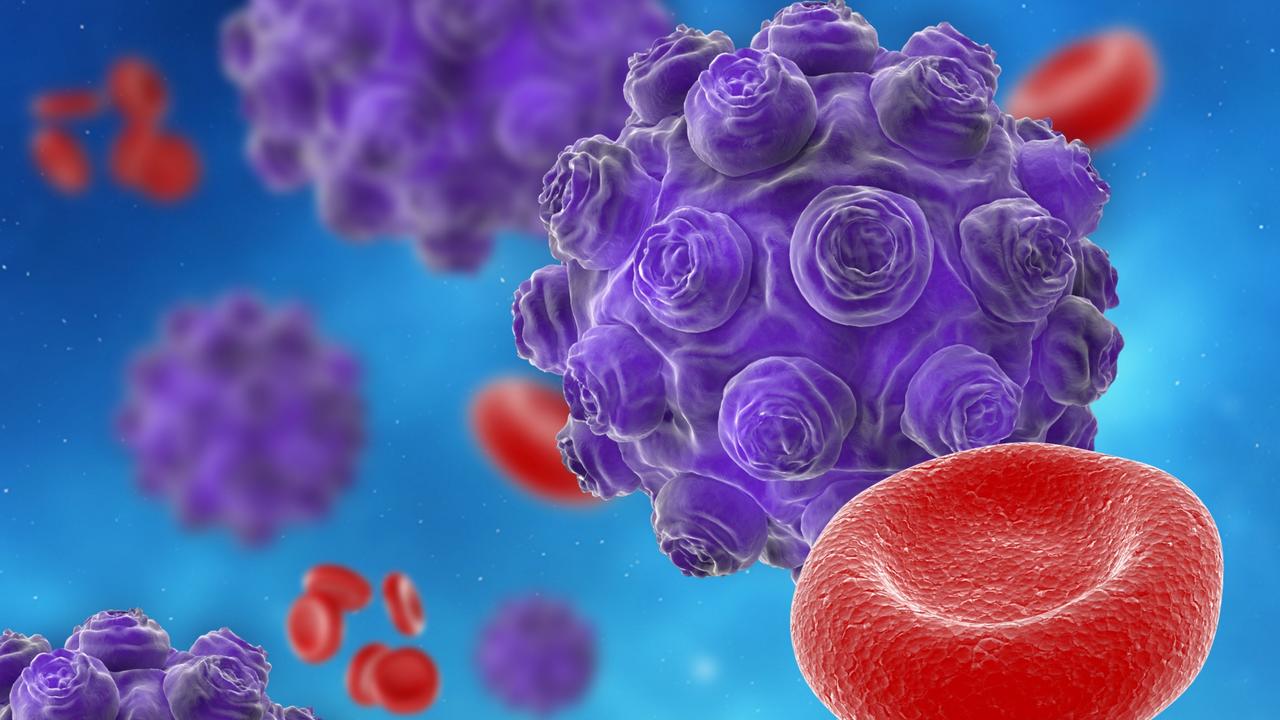
State on alert after measles case reported

Sliding doors moment which saved plane
An Aussie island that should, at this time of year, be bustling with tourists wanting to escape the dropping temperatures has, instead, been branded a “ghost town”.
Magnetic Island, located just 20 minutes from Queensland’s Townsville, has long been a popular tourist destination as it is located within the Great Barrier Reef World Heritage Area.
The island was hit hard by the Covid pandemic and, as much of the island’s economy relies on tourism, the subsequent lockdowns and travel restrictions had a huge impact on the area.
In recent years the island has begun to recover, welcoming around 290,000 visitors and supporting 25 per cent of the region’s tourism jobs, according to the Magnetic Island Tourism Masterplan.
The visitor economy on the island reportedly generates around $380,000 million in economic output for businesses within North Queensland, creating 1746 jobs.
However, it appears the island may now be facing a new kind of threat: The cost of living crisis.

A recent video uploaded to TikTok by a representative of a local kayak tour company showed a distinct lack of visitors on the island.
The poster, who goes by @crackajack9 online, claimed that Magnetic Island had seen a nearly 70 per cent drop in tourism in 2024.
He said that April and May was usually a busy time for the island, but the video showed the beaches and streets looking deserted.
“Many shops haven’t bothered to open due to the lack of customers, the tour operator said.
“Empty beaches, normally hundreds of people in April and May. Horseshoe Bay, hardly a person here since Easter.
“What needs to change to bring tourists here?”
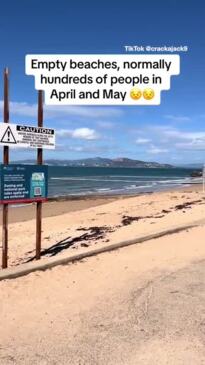
The island is home to a permanent community of around 2300 people, with the island’s economy relying heavily on tourism in order to thrive
Estimated 211 businesses operate on the island, including accommodation, restaurants, transport operators, various shops and a golf course.
The local man, who is a representative of local business Magnetic Island Sea Kayaks, shared another video at the start of April, claiming, at that time, that tourism was down 30 per cent on the island.
He did note that January, February and March were typically the quietest months on Magnetic Island “by far” due to the wet and windy weather, but he was still concerned by the very low levels of tourism he was seeing.
He suggested that Tropical Cyclone Kirrily, which impacted the Townsville area in February this year, could be one of the reasons for the drop in visitors, saying it may have “scared” off a lot of tourists during this time.
The local also noted that they had experienced higher rainfall at the start of this year, which could also deter people from making the trip to the island from Townsville.
“We had four really big days of Easter. It was absolutely packed and us locals were absolutely loving it, but since it has just gone into a ghost town,” he said.
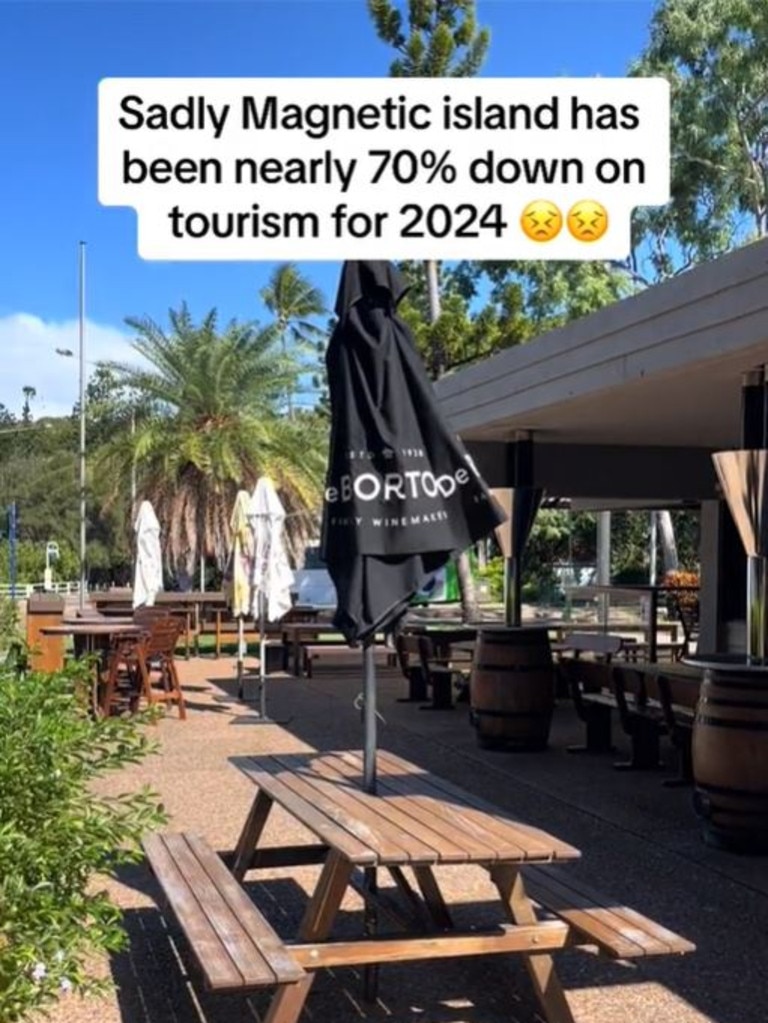
He believes one of the big reasons is the cost of living crisis, noting a lot of “people struggling this year”.
When speaking to friends who usually visit the island over the Easter period, he revealed many of them said they were choosing to stay at home this year to pick up extra shifts at work and save some money.
“I honestly don’t blame people, I think it has been a tough season, a tough year. Prices have gone through the roof with everything,” he said.
Commenters were quick to agree that the cost-of-living crisis was likely a major contributing factor.
“Everyone I know is going broke in small business and the tax debts are crippling us all,” one person said.
Another person claimed that people just have “no money” and to say that Australians are “battling” right now would be an understatement.
There are growing calls for industry leaders to help shape the future of Magnetic Island and help tourism grow in the region.
In 2023, the Magnetic Island Tourism Masterplan was published, which was created as a blueprint to manage visitor growth.
From this, the Magnetic Island Tourism Alliance (MITA) was formed, a collaborative body established to provide guidance and advice on implementing sustainable tourism developments and projects.
More Coverage

Townsville Enterprise Director Visitor Economy and Marketing, Lisa Woolfe, said the establishment of a cohesive Tourism Alliance – guided by industry – is the next crucial step in delivering opportunities for the island.
“As the Destination Management Organisation for Townsville North Queensland, Townsville Enterprise is looking forward to being part of this next evolution for the island, which we know contributes $380.2 million to our visitor economy each year,” Mrs Woolfe said.
“We are seeking passionate and experienced industry representatives who possess a deep understanding of the regional, national and global tourism landscape and who are able to effectively network and advocate for Magnetic Island – and we know there are many that fit the criteria”.
Hundreds of Australians are stranded in New Caledonia after mass rioting broke over a constitutional change in the French Pacific territory.
Health authorities in one state are on high alert after a new case of measles – the 10th this year – was reported at one of Australia’s busiest airports.
The hero pilot who saved lives on a malfunctioning plane without any landing gear has revealed exactly what happened.
6 unmissable annual events on Cape Cod and the Islands
From oyster festivals and artisanal markets to live music or sailing, discover the best annual events that embody the spirit and heritage of Cape Cod, Martha’s Vineyard and Nantucket.

Contrary to popular belief, life on Cape Cod and the Islands doesn’t come to a complete halt from Labor Day until the summer tourists return over Memorial Day weekend. Events and festivals in this corner of Massachusetts are held throughout the year, honouring diverse local groups such as artisans, farmers and musicians. These annual affairs celebrate the culture and traditions of each location and the passions of the people who call this scenic slice of New England home. Whether visitors are enticed by seafood, art galleries, wine tasting or even luxury yachts, these are six events not to miss.
1. Daffodil Festival
Nantucket - April
Who needs tulip season in Holland — or cherry blossoms in Japan, for that matter — when you have the vivid colours and fresh springtime energy of the Nantucket Daffodil Festival ? The Nantucket Garden Club hosts this annual event on the last weekend of April, which is now in its 48th year. The festival acts as a ceremonial brightening of an island otherwise known as ‘The Grey Lady’ for its famous fog.
Think festive attire, street parades and revelry. Attendees’ outfits rival the vibrant pastel blooms on display at the themed flower show at Bartlett’s Farm . Later, a daffodil-adorned antique car parade sets out from Main Street to a tailgate picnic in Siasconset. After which, springtime on the island — a notoriously tardy season in coastal New England — has officially sprung.

2. Nantucket Wine and Food Festival
Nantucket - May
Consider the Nantucket Wine & Food Festival a more mature yet equally lively version of Figawi , the hedonistic Memorial Day weekend sailing race that unofficially heralds the start of the summer season. The wine and food festival, established in 1996, occurs in early May and is frequented by a more local (or summer local) crowd. Its growth and prominence over the past couple of decades reflect Nantucket’s increasingly prestigious culinary scene, with around 600 different wines from 150 wineries around the globe on show — not bad for an island only 14 miles long.
3. Juneteenth
Martha’s Vineyard - June
Known as America’s second Independence Day, Juneteenth was recognised as a federal holiday in 2021 to commemorate 19 June 1865, when slavery was finally abolished in the US. The Juneteenth Jubilee on Martha’s Vineyard is a weekend-long multicultural extravaganza marked by the arrival of Amistad (a replica of the historic ship that was the setting for the slave revolt in 1839) in Vineyard Harbor, gospel brunch in Edgartown and the Annual Juneteenth Jubilee Cultural Festival at the Tabernacle in the town of Oak Bluffs.
Martha’s Vineyard has a storied history in the fight for freedom, demonstrating support for the abolition movement as early as 1787, when John Saunders, a former slave and preacher, introduced Methodism to Oak Bluffs. The neighbourhood — and the island at large — has remained a celebrated getaway for black families for centuries.
4. Love Local Fest
Cape Cod - July and September
The Love Local Fest showcases the artists, farmers and small business owners who make Cape Cod vibrant year-round. The event is free and open to the public and held three times annually in Hyannis’s Aselton Park — on the last Sunday in July and September and the first weekend of December. The festival is the perfect opportunity for visitors to engage with the local community and give back to this picturesque peninsula, which may be a seaside holiday destination for some, but is a home for many.

5. Wellfleet OysterFest
Cape Cod - October
While many towns in New England would like to claim they produce the tastiest oysters, Wellfleet’s salty supremacy is rarely disputed — a consensus reached centuries ago. Commercial oyster fishing in the US began in this Barnstable town in 1665, and by the mid-1800s, Wellfleet was considered the oyster capital of the world. So, what better way to celebrate Cape Cod’s most magnificent molluscs than by attending the Wellfleet OysterFest to honour the local harvest? Live music, arts and crafts, endless oysters and a shuckin’ good time awaits.
6. A Very Vineyard Holiday
Martha’s Vineyard - December
Deck the halls in true island style over Thanksgiving with A Very Vineyard Holiday , which takes place each year on the fourth Thursday of November. Martha’s Vineyard transforms into a winter wonderland with its downtown shops adorned with holiday decorations. Plus, the summer crowds have departed, making it a more intimate and jolly experience. The roster of events includes the Christmas in Edgartown Parade, wreath-making workshops, the Artists in Residence Holiday Market and more.

For Hungry Minds
- Terms of Use
- Privacy Policy
- Your US State Privacy Rights
- Children's Online Privacy Policy
- Interest-Based Ads
- About Nielsen Measurement
- Do Not Sell or Share My Personal Information
- Nat Geo Home
- Attend a Live Event
- Book a Trip
- Inspire Your Kids
- Shop Nat Geo
- Visit the D.C. Museum
- Learn About Our Impact
- Support Our Mission
- Advertise With Us
- Customer Service
- Renew Subscription
- Manage Your Subscription
- Work at Nat Geo
- Sign Up for Our Newsletters
- Contribute to Protect the Planet
Copyright © 1996-2015 National Geographic Society Copyright © 2015-2024 National Geographic Partners, LLC. All rights reserved
36 Hours on Minorca
By Yasmin Fahr May 16, 2024
- Share full article

By Yasmin Fahr Photographs by Emilio Parra Doiztua
Yasmin Fahr, a cookbook author, lives on Minorca part time.
Minorca, one of Spain’s Balearic Islands, sparkles with the same blue-green waters as its more touristy neighbors, Ibiza and Majorca. A UNESCO Biosphere Reserve since 1993, Minorca offers a quieter and wilder retreat, thanks to residents who have protected the island from further urbanization and development. Still, megayachts and crowds are descending: In 2021, the international gallery Hauser & Wirth opened a 16,000-square-foot arts center , intended to lure wealthy collectors, on an islet near the capital. Despite the encroaching threat of overtourism , Minorca sticks to its “poc a poc,” or “little by little,” way of life, in which siestas are long and opening hours are more of a suggestion. The island also brims with creativity, wildlife and rich history: Just last year, its prehistoric structures became a UNESCO World Heritage site .
Recommendations
- Camí de Cavalls is a painstakingly restored centuries-old horse path that circles the entire island and can be traveled by foot, horse or mountain bike.
- Cala Pregonda , a stunning northern beach, is accessible only by boat or a 40-minute walk, with beautiful views.
- Pedreres de s’Hostal is a quarry that has been transformed into a public space and garden by Lithica , a nonprofit foundation; it also hosts concerts during the summer months.
- S’Albufera des Grau Natural Park , a quiet marine preserve, offers hiking and bird watching.
- Paddle Tour Menorca provides tours of caves that may include snorkeling to spot colorful fish during the daytime, or at sunset, paddling out to enjoy a cold beer.
- Cala Mitjana is a beach in the south, popular for its white sand and rocky areas for sunbathing.
- Cales Coves is a swimming area where you can see burial caves from the prehistoric Talayotic civilization carved into the cliff walls.
- Algaiarens is a sandy beach where you can relax in the sun or go for a hike on the Camí de Cavalls.
- Museu de Menorca , housed in a former convent, tells the history of the island, including its Talayotic culture and various periods of occupation.
- LÔAC is a contemporary art museum that features Spanish artists in a former schoolhouse in the town of Alaior.
- Trébol , a relaxed restaurant in a picturesque port, serves fresh, local seafood.
- Sa Punta offers seasonal cuisine with a panoramic view of the water.
- Pintarroja is a lively waterfront spot to enjoy items from the grill.
- Can Padet is a cafe with pastries and gelato, as well as a charming window bar for sitting.
- Hola Ola , a beach bar, is perfect for sunset watching with a mojito.
- Molí d’es Racó serves a variety of Spanish cuisine in Es Mercadal, a town in Minorca’s center. Reservations recommended during the high season.
- El Romero is an elegant restaurant that sources local fish and vegetables.
- Island Mood features locally made items, including books, plant pots and vintage maps to bring Minorca home with you.
- Lucera is an artists’ workshop where you can peruse colorful ceramics handmade by a father-and-son team.
- Fausto has a collection of casual, modern clothing in earthy tones.
- Kiniria sells handbags made with sustainable leather.
- Carmen Cocoon offers handmade jewelry in an intimate shop with a beautiful flower display.
- Ses Orenetes is a charming homeware shop with beach blankets, linens and ceramics.
- Sent S’illa sells a thoughtful selection of women’s clothing, shoes and bags.
- Menorca Experimental is a seasonal hotel in a 19th-century farmhouse with 43 designer rooms, an 85-foot-long infinity pool, and a popular restaurant and bar. Rooms in May start from 216 euros, about $234.
- Llucasaldent Gran , another seasonal hotel, encompasses almost 250 acres where you can see grazing animals, grapevines and olive trees. Guests can tour the grounds on complimentary mountain bikes. Rooms in May start at around €252.
- Cristine Bedfor is a boutique hotel with impeccable interiors. A small pool and a lush garden provide respite from the summer heat. Rooms in May start at €215.
- For short-term rentals , the capital, Mahón, and its surrounding area are convenient for exploring the island, though availability varies with the season. Camper vans are also popular on the island.
- The best way to see the island is by renting a car . Taxis are readily available, but ride-hailing apps such as Uber and Lyft are not. There is also a bus service with routes around the island (subject to the season), with single tickets (from €1.35, cash only), available on board.

Avid bird watchers gravitate to the trails in S’Albufera des Grau Natural Park , a more than 1,200-acre protected marine reserve on the island’s eastern side, to spot birds of prey like osprey, protected red kites and booted eagles, and the spectacled or Sardinian warbler, depending on the time of year. You can spot sea turtles and land tortoises in the reserve as well as elsewhere on the island. The three main trails range in difficulty level and the duration of the walk (from 40 minutes to one hour). Free entry.

Museu de Menorca
In Mahón, the island’s capital, which has a large natural harbor, start by visiting the Museu de Menorca (4 euros, or about $4.33; opening times vary by season). The museum goes all the way from the prehistoric Talayotic civilization to the story of La Menorquina , a ice cream manufacturer founded in 1940 that still sells its desserts in stores. Afterward, visit the Gin Xoriguer distillery, whose recipe dates back to the early 1700s. Find prints of 18th-century maps and copies of Apunt , a local guidebook for cultural happenings, at Island Mood , a store full of Minorcan souvenirs. Meander along the sloping streets to one of the oldest opera houses in Spain, Teatre Principal de Maó , built in 1829. It’s surrounded by stores like Lucera , which specializes in colorful handmade ceramics.

Stroll Cales Fonts, a picturesque port lined with boats swaying in lapping green waters, before dinner. Stop at Fausto for modern clothing with earthy tones and clean lines. There are several options for dinner: Trébol , open since 1969 and with a rustic interior and casual outdoor seating, serves local products like Mahón mussels in white wine (€16) and grilled Minorcan prawns (€35). Sa Punta , slightly more formal, offers panoramic views of the water and has a thoughtful, seasonal menu that includes eggplant croquettes (€9.50) and bread made with Xeixa wheat, an ancient grain grown on the island (€3.50). For a more lively, summery vibe, share plates of oysters (€5.50), scallops (€20) and steak a la plancha (€22), at Pintarroja . (Note that many businesses on Minorca are open seasonally.)

Stroll Cales Fonts, a picturesque port lined with boats.

Slip into a beekeeping suit at Son Felip , a regenerative and organic farm in the north of the island, that includes open fields, forests, coastline and a 2,000-year-old olive tree. Xec, the agricultural director — and bee whisperer — explains the curious nature of these hard-working insects and offers a tasting of the farm’s award-winning honey before securing everyone in their bee suits to visit the hives and see the production firsthand. As he said on a recent tour, if you stay calm, then the bees will be calm — it’s time to use your yogic breathing. This two-and-a-half-hour apiculture workshop (€45) is limited to a small group and subject to time changes depending on the season, so it’s best to contact the farm ahead. Son Felip also offers farm tours, horseback riding and overnight stays.

The fish market in Ciutadella
Get lost in Ciutadella, Minorca’s capital until 1722, a town of colorful buildings, labyrinth-like cobbled streets and former palaces. Pop out onto the Contramurada, a road built atop the moat that once encircled the medieval walled center. The Minorca Cathedral (€7.20), which was constructed and restored over centuries, still marks the opening and closing of the wall gates by ringing its bell. Ciutadella is full of artisan shops: Visit Carmen Cocoon for handmade jewelry and Kiniria for leather handbags . Pick up a beach blanket at the homeware store Ses Orenetes and shop for a breezy dress at Sent S’illa . Then head to the orange-tree-studded Plaza de la Libertad, a square with a lively fish market, butcher shops and a farmers’ market. Savor a coffee at Can Padet (€1.70) and pick up some of Minorca’s best goat cheese at the Cas Ferrer de Sa Font stand.
Much is closed on the island from around 2 to 5 p.m., give or take an hour, depending on the day, season or the store owner’s whim, so it is the perfect time to visit Algaiarens Beach . There are no lounge chairs or stands for water or food, so bring whatever you’d like. To hike instead, find a red-and-white signpost near the parking lot closest to the beach; it marks the Camí de Cavalls , a 115-mile walking route that circles the island. The path, a centuries-old horse trail, has been meticulously restored to allow hikers and mountain bikers to freely experience the environmental diversity of the island. Take a one-and-a-half-hour (round-trip) hike west to Cala Morell, a cove, turning around when you hit a parking lot. A tip: If you go through a gate, always close it behind you, as it’s to protect the animals.

In Minorca’s restaurants, stores and hotels, you’ll most likely notice a sand-colored stone used for arched walkways, ceilings or walls. The stone, called marés, is found on the island. Peer into the vast depth of one of Minorca’s preserved stone quarries, Pedreres de s’Hostal , in Ciutadella. After the quarry, which dates back to the 19th century, ceased operations in the 1990s, it was at risk of being filled with rubbish. Today it is protected by the nonprofit foundation Lithica , which uses the space for concerts and other cultural events on summer evenings. The quarry area, more than 18 acres, includes gardens and mazes that are open to the public. It is recommended to book ahead, especially during the high summer season, as admission and parking are limited (€7).
End the day with a dreamy sunset paddle tour in Cala Morell, which has blue-green water perfect for snorkeling, a small beach and platforms for sunbathing and swimming. The two-hour trip with Paddle Tour Menorca (€45) includes visits to caves and ends on paddle boards on the tranquil sea, watching the sun dip into the ocean, complete with a cold beer (or water). All levels welcome, but availability is subject to the wind and season. If it’s too breezy, then head to Hola Ola , a cocktail bar about an eight-minute drive from Ciutadella’s center, which is perfectly positioned for sunset viewing. Sip a mojito made with a local gin (€9) or a refreshing beer like a Minorca-brewed Grahame Pearce or a Rosa Blanca , from Majorca (both €3.70).

Hola Ola is a beach bar that is perfectly positioned for mojitos at sunset.

For art lovers, there are galleries sprinkled throughout Minorca, like Etesian in Ciutadella or the luxe Hauser & Wirth on Isla del Rey near Mahón’s harbor. In the hilly, historic town of Alaior, LÔAC (€5), a contemporary art museum in a former schoolhouse, shows works by prominent Modern and contemporary Spanish artists, like Joan Miró and Jaume Plensa. The museum’s opening times vary with the seasons, as is the case on much of the island, so it is best to check the website before your visit.

Cales Coves
Relax by the sea, as little is open on Sundays. Minorca is windy, so choose a beach that is not facing into the gusts (the website and app Windy is helpful). In the north, Cala Pregonda is a stunning beach with golden sand, distinctive rock formations and clear waters for snorkeling or swimming. It requires an approximately 40-minute uncovered walk to reach, unless you come in by boat. In the south, Cala Mitjana offers a short walk to a white-sand beach with rocky ledges for sunbathing. Or view the burial caves of the Talayotic civilization dug into the cliffs at Cales Coves , also in the south, with rocky inlets for swimming and sunbathing. For a traditional Spanish lunch, make reservations at Molí d’es Racó in the town of Es Mercadal if you’re heading to Pregonda or Mitjana , or enjoy local fish or vegetables at El Romero in Mahón.
Have a weekend to explore a destination? We’ve got the perfect travel itinerary.
Colorado Springs: Colorado’s second-largest city, which brims with outdoor activities , is enticing visitors with a new museum and revamped hotels.
Minneapolis: Springtime is best for exploring this Midwestern city’s lakeside trails, robust arts scene and top-notch restaurants .
Maui: The beauty and hospitality of this Hawaiian island, still recovering from last year’s wildfires, remain as vibrant as ever .
Toronto: Savor the diversity of this lakefront city through its hidden bars, small-but-fascinating museums and vibrant restaurants .
Cape Town: Take a food and storytelling tour, cruise one of the world’s most beautiful coastal drives and see contemporary African art in this city with stunning views in every direction .
Advertisement
- Skip to global NPS navigation
- Skip to the main content
- Skip to the footer section

Exiting nps.gov
Top ten tips for visiting padre island national seashore, plan like a park ranger.
Coming out to the park? Here are some tips to make your trip to the wild, western coastline of the Gulf of Mexico and unforgettable experience!
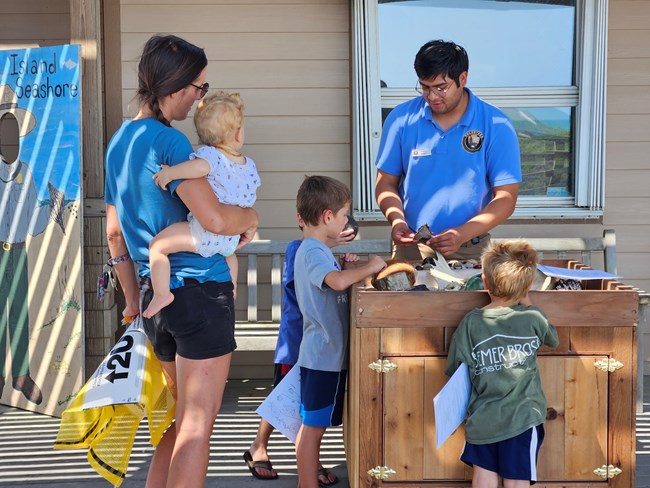
1. Have a plan…. And a backup plan
Because backups get you back out! Beach conditions are constantly changing here at the national seashore. Before you head this way, check the weather and tides . If driving on the beach , plan on bringing everything you need to be self-sufficient like food, water, and self-rescue gear. By following some simple safety guidelines , you can have a fun visit without having to resort to plan b!
2. Ask a Ranger
Have a question? Need a map? Just ask a ranger! Helpful rangers are on-site at Malaquite Visitor Center to inform you about beach conditions, identify that bird you saw, share a park story, and more. The Visitor Center is open from 9 am to 5 pm every day. Have a question after hours? See #3!
3. There’s an app for that!
Bad internet reception? Want information about the park but don’t actually want to talk to a person? Use the NPS App ! With the app you can download content, maps, and get information in areas of the park with poor cell service… which, let’s be real, is basically most of the park. Download the app before coming to the park or use the free WiFi at the Malaquite Visitor Center and never be without the information you need!
4. Leave only footprints
Because of the way ocean currents flow in the Gulf of Mexico, the national seashore gets a lot of marine debris washing in. Please don’t add to the litter by being a messy beachgoer! Follow the Leave No Trace principles to respect the environment and other park visitors. Want to do something about all the trash? Free trash bags are available at Malaquite Visitor Center and entrances to North and South Beaches.

5. Hydrate!
It gets hot here! Staying hydrated is extremely important when being active outside in the summer. Something as simple as not drinking enough water can put the brakes on a fun day at the beach. We have several water filling stations at the Malaquite Visitor Center so bring a reusable bottle and fill up! We promise there will still be enough water for the fish!
6. This one’s for the dogs
We love pets and want them to share your adventures in the park. You can keep your pet safe by observing a few simple rules. Following our pet regulations will ensure all two-legged and four-legged park visitors have a grrrr-eat time while here.

7. In it for the long haul… tips for traveling down island
Traveling down island to experience the southern end of the park might be on your bucket list. If so, make sure you’re prepared for the trip! Check the tides , weather , and rules and recommendations for down island travel so your trip of a lifetime won’t become your biggest regret.
8. Got snacks? We do!
There isn’t a restaurant or sandwich shop in the park so be prepared! The park store sells small snacks, water, ice, and other sundry items. If you need anything more than that, you’ll need to bring it with you or go back into town. Also, the park is a perfect place to picnic but keep wildlife wild and don’t feed the animals !

9. Explore the park, after dark!
Have a fun day at the beach and stay for the evening encore. After the sun goes down, you can enjoy stargazing or a night hike on the beach. Learn more about how to keep yourself safe on a nocturnal excursion through the park.
10. Location, location, location
When traveling here, you may encounter some directional issues. Often, we get visitors asking if they can drive through the park to South Padre Island. As the pelican flies, South Padre looks close on the map but in reality, it is almost 4 hours away. Additionally, GPS systems and digital map services don’t always guide you all the way into the park. Check out a map and get directions (including GPS information!) to make sure you arrive at your intended destination!
You Might Also Like
- padre island national seashore
- plan like a park ranger
- padre island
- top 10 tips
Padre Island National Seashore
Last updated: May 19, 2024
Firefighters respond to flooding in Auckland as heavy downpours lash the North Island
- 2 hours ago
- Melania Watson
Watch: Several Auckland properties have been flooded overnight. Credits: Video: AM; Images: Supplied/MetService
Firefighters have been called to dozens of reports of flooding and leaky roofs in Auckland overnight.
Torrential downpours hit parts of Auckland and Coromandel overnight, bringing large amounts of rainfall.
Between 11pm and 2am, Fire and Emergency (FENZ) received 67 calls in relation to weather incidents in Auckland.
Suburbs that faced the brunt of the rain include St Heliers, Kohimarama, Mt Wellington, and parts of South Auckland.
Most of the emergency callouts were for leaky roofs and flooding.
Emergency services also responded to 28 alarm activations in commercial buildings, which were set off as a result of the weather.
Significant downpours were recorded right across Auckland, with Leigh recording 81mm of rain in just one hour.
FENZ also responded to three minor flooding jobs in Putāruru in south Waikato, where crews have been working to stop water from entering buildings and clear blocked drains.
Posts to Facebook suggest several roads in the town are underwater and there is some flooding at the town's supermarket.
It comes after a severe thunderstorm watch was issued for regions across the North Island on Monday night.
More from Newshub
MetService put out the notice to those in Northland, Auckland, Great Barrier Island and Coromandel Peninsula, due to an active front masking its way across central and northern parts of Northland.
"There is a moderate risk of severe thunderstorms with this front, especially about coastal areas, with localised downpours of 25 to 40mm/h possible. There is also a chance of a small coastal tornado," the weather agency said.
Meanwhile, a heavy rain warning is in place for Hawke's Bay from 6am today until 6pm Wednesday.

Texas A&M Galveston to close for days after barge slams into bridge to island
A barge slammed into a bridge in Galveston, Texas, on Wednesday, spilling oil into the bay, forcing a shutdown of the span and prompting the university on the other side of the bridge to close its campus through the weekend, officials said.
Texas A&M University at Galveston said Wednesday evening that the campus on Pelican Island would be closed Thursday through Sunday , citing an " extended outage of the bridge through the weekend," according to the university announcement.
Aerial images showed that a section of a rail line alongside the bridge appeared to have collapsed, with slabs of concrete piled on the barge.
No injuries were immediately reported at the Pelican Island Causeway after the incident, which unfolded shortly before 10 a.m. CT, the city of Galveston said in a statement .
Two operators were on the barge at the time of the impact, said Spencer Lewis, a spokesperson for the Galveston County Office of Emergency Management.
Lewis said that one of the operators fell into the water but was immediately rescued and that the other remained on the barge and was eventually rescued, as well. The Texas A&M marine unit rescued the operators.
The bridge, which was closed earlier Wednesday, had been reopened as of 7 p.m. CT to slow vehicular traffic, and a large line of cars was trying to exit Pelican Island, Lewis said.
The bridge is open only for outbound traffic, he said.
About 200 people were on the island at the time of the incident, and “substantially more than half” have been evacuated, Lewis said.
About 450 people — most of them students — live full time on Pelican Island. Faculty members and other workers make up the rest of the residents, he said.
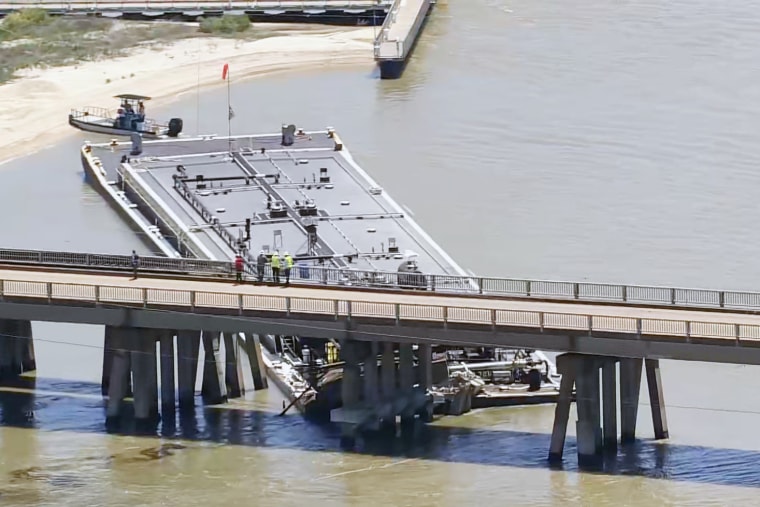
Texas A&M University at Galveston is offering accommodations to students and faculty members who live on Pelican Island — which is also home to a fishing pier, a naval museum and other industries — but it also encouraged those who stay on campus to prepare to leave if necessary.
The university, which held its graduation ceremony last week, briefly lost power on campus earlier Wednesday, but it was restored quickly, the school said.
Classes scheduled for Thursday and Friday will either be canceled or held remotely, the school said in its evening update, and it encouraged employees to work at alternative locations. Dining services will remain open until 8 p.m. Wednesday.
The barge that hit the bridge was “carrying a base petroleum product,” the Coast Guard said in a statement .
The city said: “The collision has resulted in an oil spill in the bay. The U.S. Coast Guard is responding and will determine the extent of the spill, as well as initiate the containment and cleanup processes.”
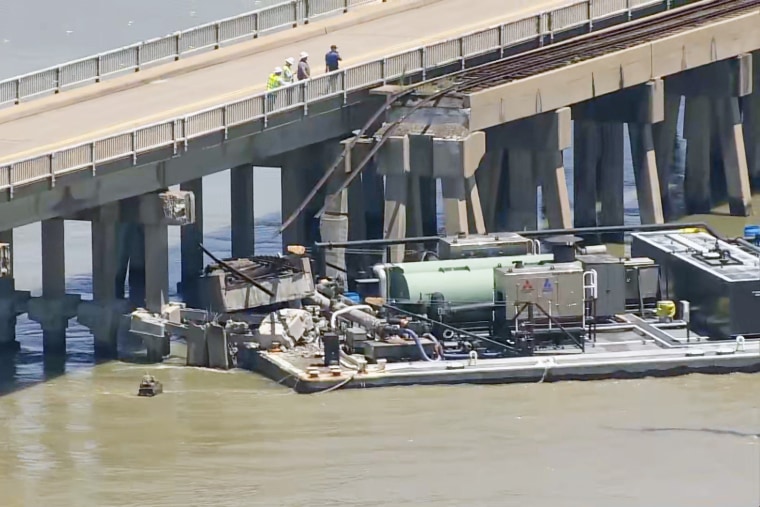
The accident is the latest to plague American bridges and highways.
A container ship hit the Francis Scott Key Bridge in Baltimore on March 6, killing six people .
The Fort Madison Toll Bridge , which turns 97 in July and connects Fort Madison, Iowa, with Niota, Illinois, over the Mississippi River, was struck by a barge Thursday .
Two weeks ago, Interstate 95 in Connecticut was closed after a tanker truck filled with gasoline burst into flames and forced the closure of the one of the Eastern Seaboard's most important thoroughfares.
In late March, a family out fishing on the Arkansas River captured video of a barge hitting a bridge near Sallisaw, Oklahoma. And in April, more than two dozen barges broke loose from moorings and floated down the Ohio River in Pittsburgh, striking the Sewickley Bridge .
Galveston fire spokesperson Marissa Barnett said barges go under the bridge multiple times a day.
She pushed back against any comparisons between the Baltimore bridge collapse and Wednesday's incident.
“People have asked if this is like the Baltimore bridge. This is not that,” she said.
CORRECTION (May 15, 2024, 9:24 p.m. ET): A previous version of this article misstated the last name of the spokesperson for the Galveston County Office of Emergency Management. He is Spencer Lewis, not Jones.
David K. Li is a senior breaking news reporter for NBC News Digital.
Rebecca Cohen is a breaking news reporter for NBC News.

IMAGES
VIDEO
COMMENTS
The typical activities visitors get up to on Palmerston Island include the following: Visiting the school - Visitors are welcome to visit the school, sit in on classes and take a tour of their local vegetable gardens with the kids. Fishing - You'll meet fisherfolk fishing from shore, as well as within the lagoon.
They are a regular on the dining table and exported to Rarotonga when the ship comes in. Vegetation on the island is also lush with palm trees, pandanus and natives. But Palmerston's fame comes not only from the fact it is a perfect island paradise. Its history is unique in the Cooks. And though Captain Cook may have finally landed in 1777 ...
Palmerston Island is a coral atoll in the Cook Islands in one of the most isolated part of the Pacific Ocean, about 3,200 km from New Zealand. The tiny Pacific island has no airport, and is visited by a supply ship only twice a year. The journey to the island is so long and hazardous that only the most intrepid visitors ever dares to visit it.
7. Palmerston Island. Palmerston Island Tourism: Tripadvisor has reviews of Palmerston Island Hotels, Attractions, and Restaurants making it your best Palmerston Island resource.
Palmerston Island. Palmerston Island is a coral atoll which includes five small island groups. It is one of the Southern Cook Islands. It has no airstrip; access is by sea only. It is famed for its hospitality to yachts, and is sometimes compared to Pitcairn Island as they are both remote islands supporting small English-speaking populations.
A continuous ring of a coral reef encircling a lagoon includes several sandy islands, including Palmerston Island. Home is the lone inhabited islet. The islands' total land area is around one square mile (2.6 km2). There are roughly 3,600 acres of coral reef (15 km2). The lagoon spans an area of around 22 square miles and is about 7 miles (11 km) broad (57 km2).
A huge lagoon surrounds Palmerston, which is shaped like a delicate necklace in the Pacific with a coral reef, white beaches, six sand Motus, and a coral reef strung throughout. Although the tiny islands of Palmerston, North Island, Lee To Us, Leicester, Primrose, Tons. Cooks have a combined land area of just around one square mile, the coral reef, which surrounds a stunning blue lagoon with a ...
Communication to the outside world is provided by Vodafone Cook Islands, including landline, internet and cellular phone service. The island has no airport or air service, but cargo ships visit a few times a year. History. Palmerston was recorded by Captain Cook in 1774, but he did not land on the island until 13 April 1777.
7. PLAN YOUR TRIP. Palmerston Island. Palmerston Island Tourism: Tripadvisor has reviews of Palmerston Island Hotels, Attractions, and Restaurants making it your best Palmerston Island resource.
Nearly 2,000 miles northeast of New Zealand, Palmerston is 500 miles away from the Cook Islands' capital and main population center, Rarotonga. The atoll has no airport or any commercial service ...
Palmerston Island is the westernmost islet of a coral atoll belonging to the Cook Islands in the Pacific Ocean. Just sixty two people - all from the same bloodline - occupy the remote island, which sits approximately 2,000 miles (3,200 km) northeast of New Zealand and 2,850 miles (4,590 km) southwest of Hawaii. ... If you do visit ...
Palmerston Island Vita Statistics. Not actually an island, but a bunch of atolls surrounding a lagoon, a bit like Funafuti. The main islet and the one that is inhabited is Home Island. Location Central-Southern Pacific Ocean. Coordinates Coordinates: 18°04′S 163°10′W.
Palmerston Island is a small coral atoll that is located in the South Pacific Ocean, and it is part of the self-governing island country in free association with New Zealand, the Cook Islands. Even though the islands are called the Cook Islands, Palmerston is the only one on which Captain Cook ever set foot himself. At first, Captain Cook discovered this beautiful atoll in 1774, however, he ...
A Visit to Palmerston Island One of the more unique experiences available to cruisers traveling in the Cook Islands is a visit to Palmerston Island. Palmerston Atoll is one of the largest atolls in the South Pacific, consisting of approximately 22 motus surrounded by a reef and lagoon, and Palmerston Island is its only inhabited motu. ...
Description: island in the Cook Islands. Categories: island group and landform. Location: Southern Cook Islands, Cook Islands, Polynesia, Oceania. View on OpenStreetMap. Latitude. -18.0583° or 18° 3' 30" south. Longitude. -163.1597° or 163° 9' 35" west. Open Location Code.
The Must-Dos in Palmerston North. Conveniently located just a quick detour on the way between Taupo and Wellington, Palmerston North provides an interesting stop on a North Island road trip. The vibrant city is packed with beautiful parks, museums and restaurants, ideal for a short visit.
Palmerston Island, Cook Islands ... Travel Resources Travel Resources. Check in Manage My Cruise Health Protocols News & Advisories Accessibility Download Brochures Buy a Gift for a Guest About Us About ...
Palmerston North for Luxury Travellers. Palmerston North is your premier city destination for countryside living in the lower North Island. Play on New Zealand's original golf course, ride among lush farmland on horseback, and visit the city's surrounding villages and their boutiques.
Wander Around the Square. 4. Visit New Zealand's Oldest Golf Course. 5. Visit the Te Manawa Museum of Art, Science, and Heritage. 6. Enjoy a Day Trip to Te Āpiti - Manawatū Gorge. 7. Head Out on Some of Palmerston North's Mountain Biking Trails.
Palmerston Island is actually a coral atoll which includes five small island groups. It is one of the Southern Cook Islands. It has no airstrip; access is by sea only. It is famed for its hospitality to traveling yachts and is sometimes compared to Pitcairn Island, as they are both remote islands supporting small English-speaking populations.
Courtesy of Stout's Island Lodge. The island was once owned by lumber baron Frank S. Stout, who first purchased the land in 1887 with a partner Thomas Wilson, Jr., and then bought it completely in ...
The island is home to a permanent community of around 2300 people, with the island's economy relying heavily on tourism in order to thrive. Estimated 211 businesses operate on the island ...
Travel between Cape Cod and the Islands is possible on ferries operated by Hy-Line Cruises, the Steamship Authority and the Island Queen, or via short flights. For more information, go to visitma.com
Avid bird watchers gravitate to the trails in S'Albufera des Grau Natural Park, a more than 1,200-acre protected marine reserve on the island's eastern side, to spot birds of prey like osprey ...
7. In it for the long haul… tips for traveling down island. Traveling down island to experience the southern end of the park might be on your bucket list. If so, make sure you're prepared for the trip! Check the tides, weather, and rules and recommendations for down island travel so your trip of a lifetime won't become your biggest regret. 8.
Travel on the Pelican Island Causeway Bridge is limited Thursday, May 16, 2024, after a barge hit the structure Wednesday morning leading to a closure and oil spill. Skip Navigation.
MetService put out the notice to those in Northland, Auckland, Great Barrier Island and Coromandel Peninsula, due to an active front masking its way across central and northern parts of Northland.
East Hampton is another one of the best towns on Long Island to visit; it's a historic and picturesque town popular for its beautiful beaches, elegant estates, and vibrant arts scene. Perhaps most ...
The bridge, which was closed earlier Wednesday, had been reopened as of 7 p.m. CT to slow vehicular traffic, and a large line of cars was trying to exit Pelican Island, Lewis said.